Marketing Fundamentals
VerifiedAdded on 2022/11/25
|20
|4989
|443
AI Summary
This study material provides an in-depth analysis of marketing fundamentals and strategies using Qantas airline as a case study. It covers topics such as micro and macro environment analysis, marketing objectives, and marketing mix. The material also includes a SWOT analysis of Qantas airline and discusses its strengths, weaknesses, opportunities, and threats.
Contribute Materials
Your contribution can guide someone’s learning journey. Share your
documents today.
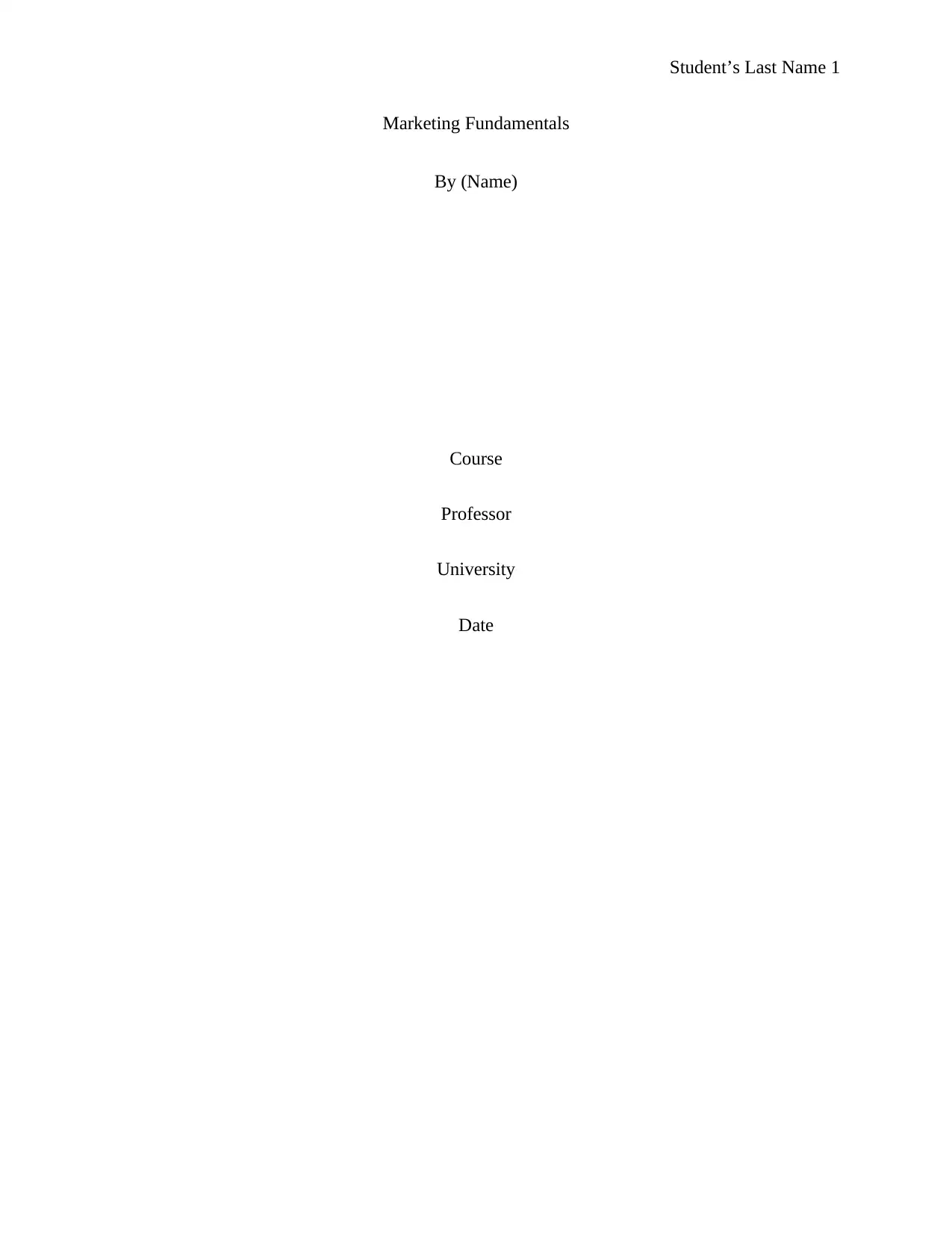
Student’s Last Name 1
Marketing Fundamentals
By (Name)
Course
Professor
University
Date
Marketing Fundamentals
By (Name)
Course
Professor
University
Date
Secure Best Marks with AI Grader
Need help grading? Try our AI Grader for instant feedback on your assignments.
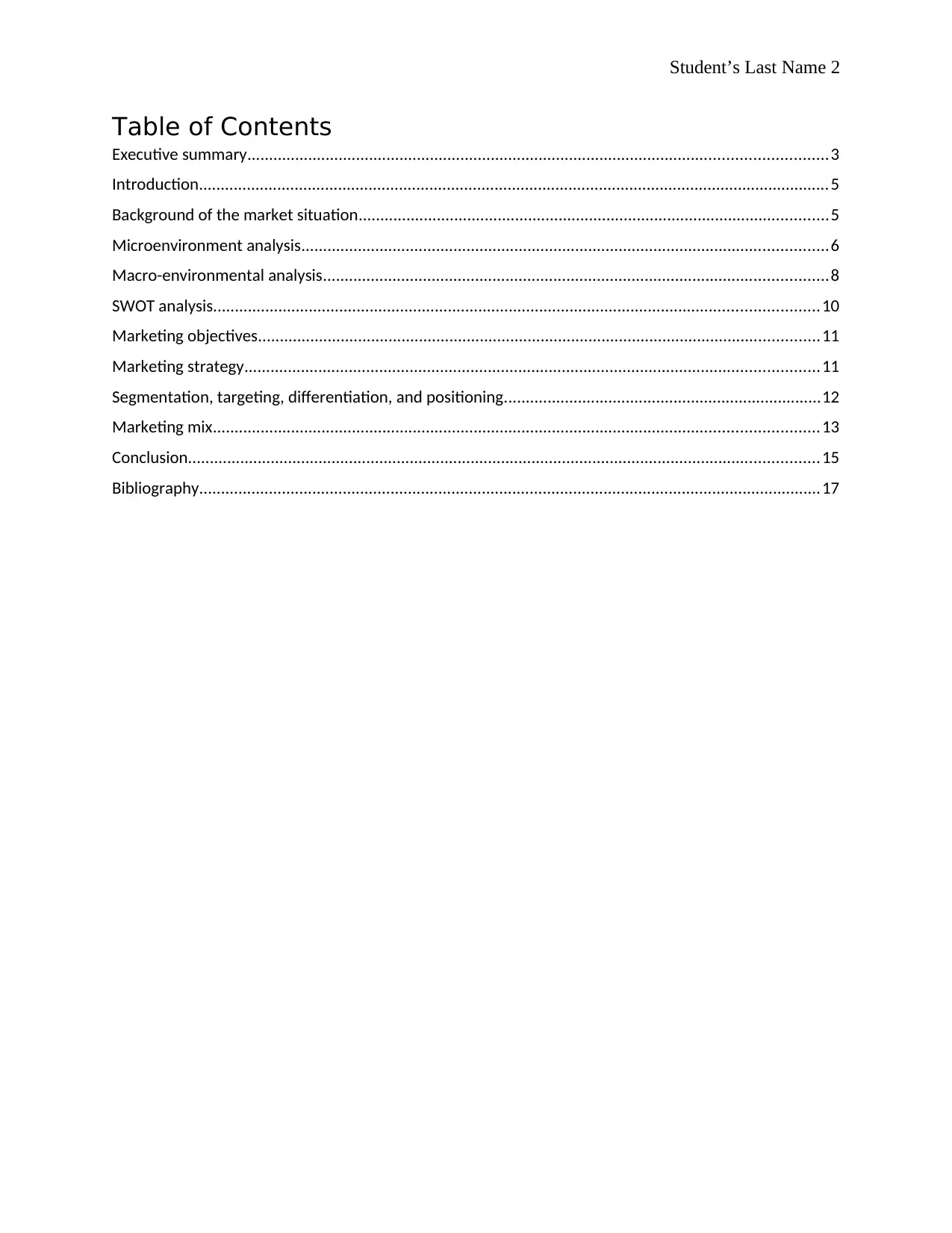
Student’s Last Name 2
Table of Contents
Executive summary.....................................................................................................................................3
Introduction.................................................................................................................................................5
Background of the market situation............................................................................................................5
Microenvironment analysis.........................................................................................................................6
Macro-environmental analysis....................................................................................................................8
SWOT analysis...........................................................................................................................................10
Marketing objectives.................................................................................................................................11
Marketing strategy....................................................................................................................................11
Segmentation, targeting, differentiation, and positioning.........................................................................12
Marketing mix...........................................................................................................................................13
Conclusion.................................................................................................................................................15
Bibliography...............................................................................................................................................17
Table of Contents
Executive summary.....................................................................................................................................3
Introduction.................................................................................................................................................5
Background of the market situation............................................................................................................5
Microenvironment analysis.........................................................................................................................6
Macro-environmental analysis....................................................................................................................8
SWOT analysis...........................................................................................................................................10
Marketing objectives.................................................................................................................................11
Marketing strategy....................................................................................................................................11
Segmentation, targeting, differentiation, and positioning.........................................................................12
Marketing mix...........................................................................................................................................13
Conclusion.................................................................................................................................................15
Bibliography...............................................................................................................................................17
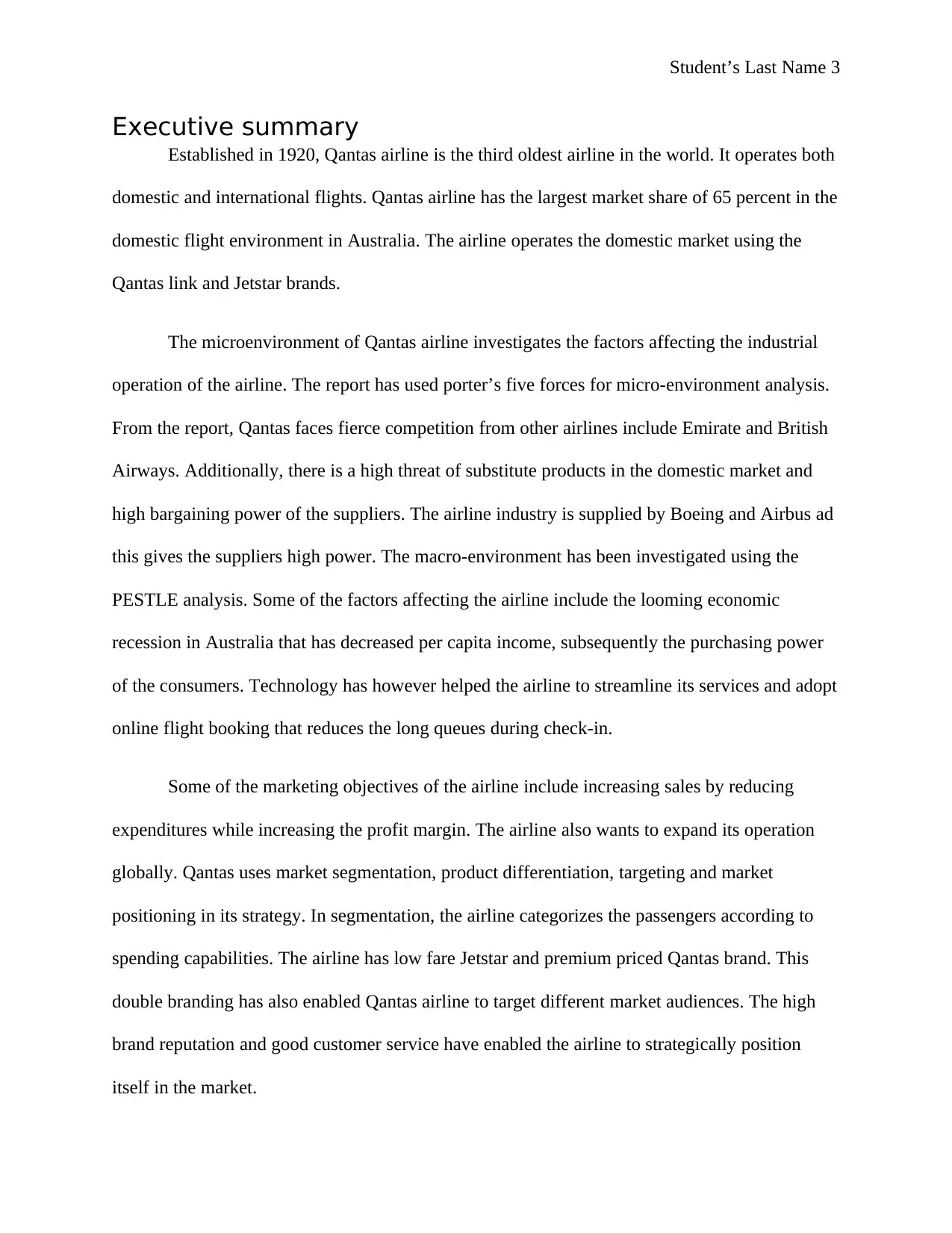
Student’s Last Name 3
Executive summary
Established in 1920, Qantas airline is the third oldest airline in the world. It operates both
domestic and international flights. Qantas airline has the largest market share of 65 percent in the
domestic flight environment in Australia. The airline operates the domestic market using the
Qantas link and Jetstar brands.
The microenvironment of Qantas airline investigates the factors affecting the industrial
operation of the airline. The report has used porter’s five forces for micro-environment analysis.
From the report, Qantas faces fierce competition from other airlines include Emirate and British
Airways. Additionally, there is a high threat of substitute products in the domestic market and
high bargaining power of the suppliers. The airline industry is supplied by Boeing and Airbus ad
this gives the suppliers high power. The macro-environment has been investigated using the
PESTLE analysis. Some of the factors affecting the airline include the looming economic
recession in Australia that has decreased per capita income, subsequently the purchasing power
of the consumers. Technology has however helped the airline to streamline its services and adopt
online flight booking that reduces the long queues during check-in.
Some of the marketing objectives of the airline include increasing sales by reducing
expenditures while increasing the profit margin. The airline also wants to expand its operation
globally. Qantas uses market segmentation, product differentiation, targeting and market
positioning in its strategy. In segmentation, the airline categorizes the passengers according to
spending capabilities. The airline has low fare Jetstar and premium priced Qantas brand. This
double branding has also enabled Qantas airline to target different market audiences. The high
brand reputation and good customer service have enabled the airline to strategically position
itself in the market.
Executive summary
Established in 1920, Qantas airline is the third oldest airline in the world. It operates both
domestic and international flights. Qantas airline has the largest market share of 65 percent in the
domestic flight environment in Australia. The airline operates the domestic market using the
Qantas link and Jetstar brands.
The microenvironment of Qantas airline investigates the factors affecting the industrial
operation of the airline. The report has used porter’s five forces for micro-environment analysis.
From the report, Qantas faces fierce competition from other airlines include Emirate and British
Airways. Additionally, there is a high threat of substitute products in the domestic market and
high bargaining power of the suppliers. The airline industry is supplied by Boeing and Airbus ad
this gives the suppliers high power. The macro-environment has been investigated using the
PESTLE analysis. Some of the factors affecting the airline include the looming economic
recession in Australia that has decreased per capita income, subsequently the purchasing power
of the consumers. Technology has however helped the airline to streamline its services and adopt
online flight booking that reduces the long queues during check-in.
Some of the marketing objectives of the airline include increasing sales by reducing
expenditures while increasing the profit margin. The airline also wants to expand its operation
globally. Qantas uses market segmentation, product differentiation, targeting and market
positioning in its strategy. In segmentation, the airline categorizes the passengers according to
spending capabilities. The airline has low fare Jetstar and premium priced Qantas brand. This
double branding has also enabled Qantas airline to target different market audiences. The high
brand reputation and good customer service have enabled the airline to strategically position
itself in the market.
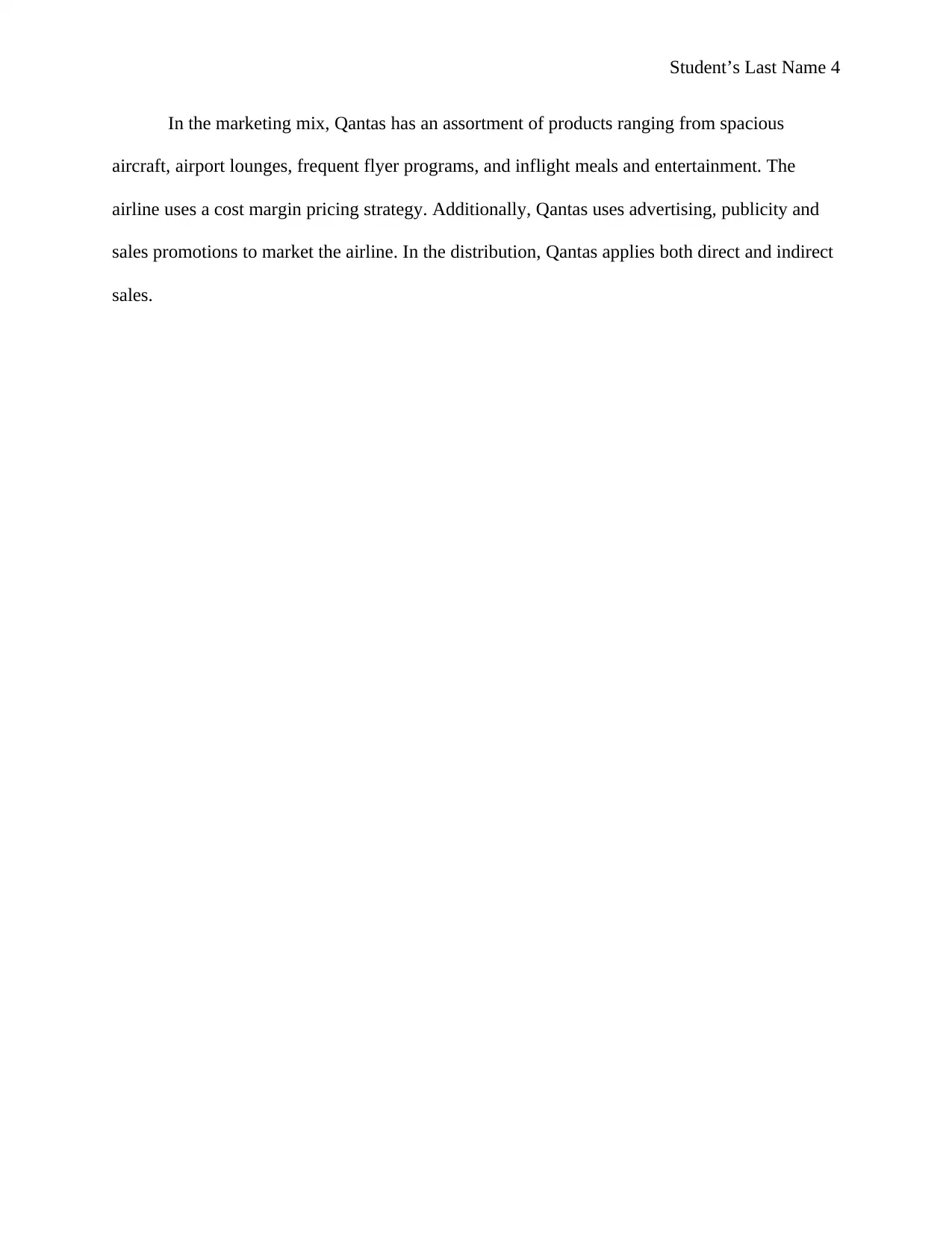
Student’s Last Name 4
In the marketing mix, Qantas has an assortment of products ranging from spacious
aircraft, airport lounges, frequent flyer programs, and inflight meals and entertainment. The
airline uses a cost margin pricing strategy. Additionally, Qantas uses advertising, publicity and
sales promotions to market the airline. In the distribution, Qantas applies both direct and indirect
sales.
In the marketing mix, Qantas has an assortment of products ranging from spacious
aircraft, airport lounges, frequent flyer programs, and inflight meals and entertainment. The
airline uses a cost margin pricing strategy. Additionally, Qantas uses advertising, publicity and
sales promotions to market the airline. In the distribution, Qantas applies both direct and indirect
sales.
Secure Best Marks with AI Grader
Need help grading? Try our AI Grader for instant feedback on your assignments.
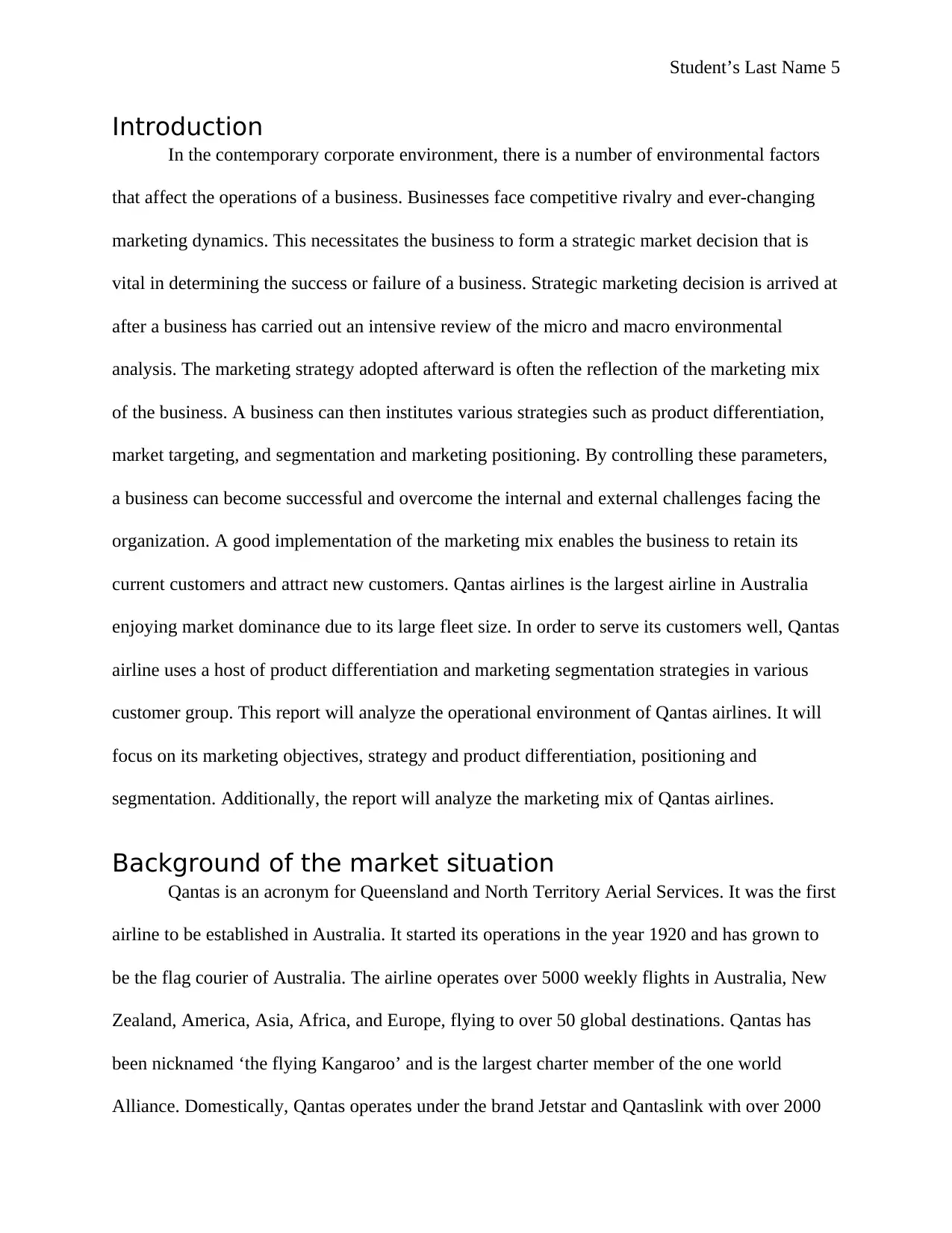
Student’s Last Name 5
Introduction
In the contemporary corporate environment, there is a number of environmental factors
that affect the operations of a business. Businesses face competitive rivalry and ever-changing
marketing dynamics. This necessitates the business to form a strategic market decision that is
vital in determining the success or failure of a business. Strategic marketing decision is arrived at
after a business has carried out an intensive review of the micro and macro environmental
analysis. The marketing strategy adopted afterward is often the reflection of the marketing mix
of the business. A business can then institutes various strategies such as product differentiation,
market targeting, and segmentation and marketing positioning. By controlling these parameters,
a business can become successful and overcome the internal and external challenges facing the
organization. A good implementation of the marketing mix enables the business to retain its
current customers and attract new customers. Qantas airlines is the largest airline in Australia
enjoying market dominance due to its large fleet size. In order to serve its customers well, Qantas
airline uses a host of product differentiation and marketing segmentation strategies in various
customer group. This report will analyze the operational environment of Qantas airlines. It will
focus on its marketing objectives, strategy and product differentiation, positioning and
segmentation. Additionally, the report will analyze the marketing mix of Qantas airlines.
Background of the market situation
Qantas is an acronym for Queensland and North Territory Aerial Services. It was the first
airline to be established in Australia. It started its operations in the year 1920 and has grown to
be the flag courier of Australia. The airline operates over 5000 weekly flights in Australia, New
Zealand, America, Asia, Africa, and Europe, flying to over 50 global destinations. Qantas has
been nicknamed ‘the flying Kangaroo’ and is the largest charter member of the one world
Alliance. Domestically, Qantas operates under the brand Jetstar and Qantaslink with over 2000
Introduction
In the contemporary corporate environment, there is a number of environmental factors
that affect the operations of a business. Businesses face competitive rivalry and ever-changing
marketing dynamics. This necessitates the business to form a strategic market decision that is
vital in determining the success or failure of a business. Strategic marketing decision is arrived at
after a business has carried out an intensive review of the micro and macro environmental
analysis. The marketing strategy adopted afterward is often the reflection of the marketing mix
of the business. A business can then institutes various strategies such as product differentiation,
market targeting, and segmentation and marketing positioning. By controlling these parameters,
a business can become successful and overcome the internal and external challenges facing the
organization. A good implementation of the marketing mix enables the business to retain its
current customers and attract new customers. Qantas airlines is the largest airline in Australia
enjoying market dominance due to its large fleet size. In order to serve its customers well, Qantas
airline uses a host of product differentiation and marketing segmentation strategies in various
customer group. This report will analyze the operational environment of Qantas airlines. It will
focus on its marketing objectives, strategy and product differentiation, positioning and
segmentation. Additionally, the report will analyze the marketing mix of Qantas airlines.
Background of the market situation
Qantas is an acronym for Queensland and North Territory Aerial Services. It was the first
airline to be established in Australia. It started its operations in the year 1920 and has grown to
be the flag courier of Australia. The airline operates over 5000 weekly flights in Australia, New
Zealand, America, Asia, Africa, and Europe, flying to over 50 global destinations. Qantas has
been nicknamed ‘the flying Kangaroo’ and is the largest charter member of the one world
Alliance. Domestically, Qantas operates under the brand Jetstar and Qantaslink with over 2000
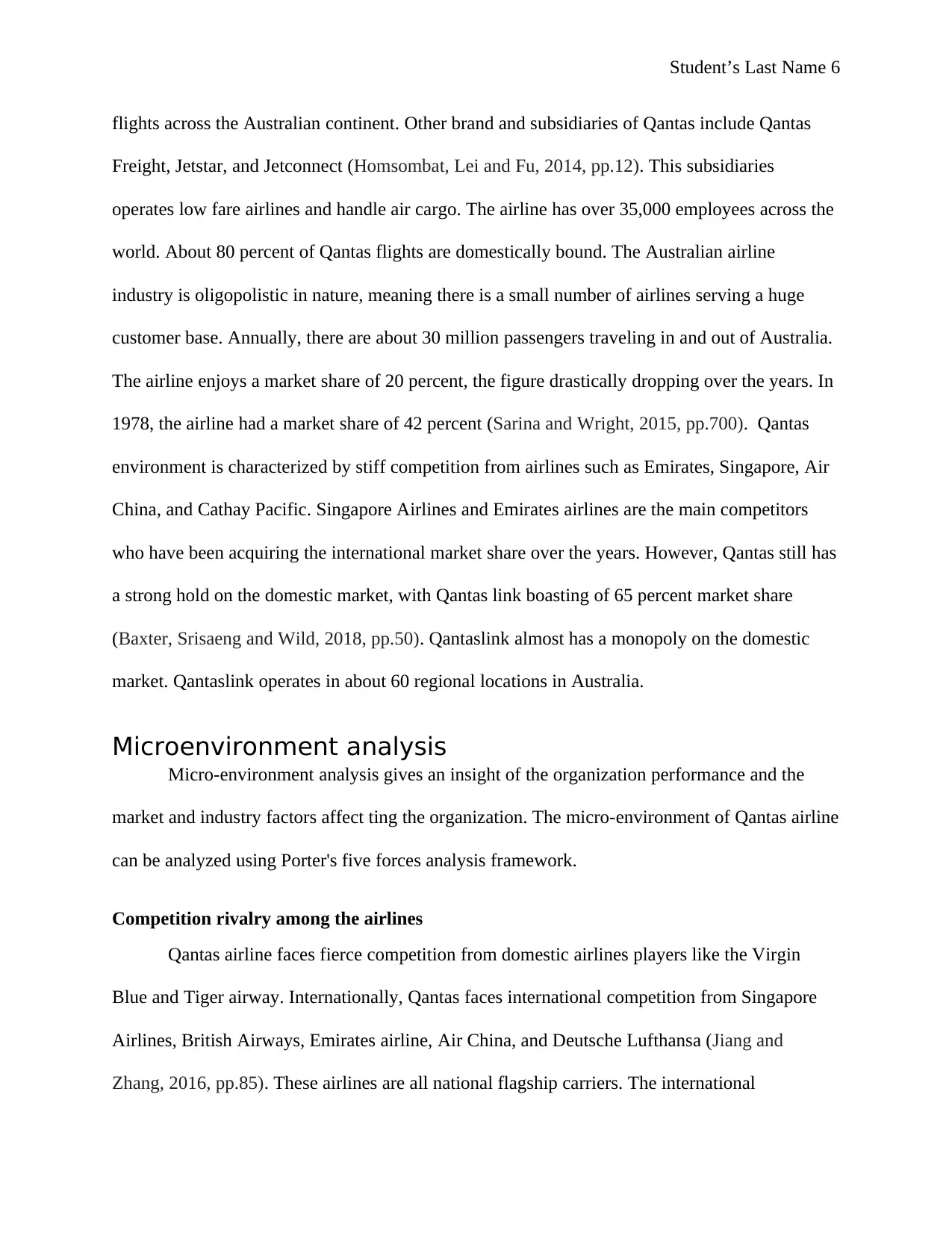
Student’s Last Name 6
flights across the Australian continent. Other brand and subsidiaries of Qantas include Qantas
Freight, Jetstar, and Jetconnect (Homsombat, Lei and Fu, 2014, pp.12). This subsidiaries
operates low fare airlines and handle air cargo. The airline has over 35,000 employees across the
world. About 80 percent of Qantas flights are domestically bound. The Australian airline
industry is oligopolistic in nature, meaning there is a small number of airlines serving a huge
customer base. Annually, there are about 30 million passengers traveling in and out of Australia.
The airline enjoys a market share of 20 percent, the figure drastically dropping over the years. In
1978, the airline had a market share of 42 percent (Sarina and Wright, 2015, pp.700). Qantas
environment is characterized by stiff competition from airlines such as Emirates, Singapore, Air
China, and Cathay Pacific. Singapore Airlines and Emirates airlines are the main competitors
who have been acquiring the international market share over the years. However, Qantas still has
a strong hold on the domestic market, with Qantas link boasting of 65 percent market share
(Baxter, Srisaeng and Wild, 2018, pp.50). Qantaslink almost has a monopoly on the domestic
market. Qantaslink operates in about 60 regional locations in Australia.
Microenvironment analysis
Micro-environment analysis gives an insight of the organization performance and the
market and industry factors affect ting the organization. The micro-environment of Qantas airline
can be analyzed using Porter's five forces analysis framework.
Competition rivalry among the airlines
Qantas airline faces fierce competition from domestic airlines players like the Virgin
Blue and Tiger airway. Internationally, Qantas faces international competition from Singapore
Airlines, British Airways, Emirates airline, Air China, and Deutsche Lufthansa (Jiang and
Zhang, 2016, pp.85). These airlines are all national flagship carriers. The international
flights across the Australian continent. Other brand and subsidiaries of Qantas include Qantas
Freight, Jetstar, and Jetconnect (Homsombat, Lei and Fu, 2014, pp.12). This subsidiaries
operates low fare airlines and handle air cargo. The airline has over 35,000 employees across the
world. About 80 percent of Qantas flights are domestically bound. The Australian airline
industry is oligopolistic in nature, meaning there is a small number of airlines serving a huge
customer base. Annually, there are about 30 million passengers traveling in and out of Australia.
The airline enjoys a market share of 20 percent, the figure drastically dropping over the years. In
1978, the airline had a market share of 42 percent (Sarina and Wright, 2015, pp.700). Qantas
environment is characterized by stiff competition from airlines such as Emirates, Singapore, Air
China, and Cathay Pacific. Singapore Airlines and Emirates airlines are the main competitors
who have been acquiring the international market share over the years. However, Qantas still has
a strong hold on the domestic market, with Qantas link boasting of 65 percent market share
(Baxter, Srisaeng and Wild, 2018, pp.50). Qantaslink almost has a monopoly on the domestic
market. Qantaslink operates in about 60 regional locations in Australia.
Microenvironment analysis
Micro-environment analysis gives an insight of the organization performance and the
market and industry factors affect ting the organization. The micro-environment of Qantas airline
can be analyzed using Porter's five forces analysis framework.
Competition rivalry among the airlines
Qantas airline faces fierce competition from domestic airlines players like the Virgin
Blue and Tiger airway. Internationally, Qantas faces international competition from Singapore
Airlines, British Airways, Emirates airline, Air China, and Deutsche Lufthansa (Jiang and
Zhang, 2016, pp.85). These airlines are all national flagship carriers. The international
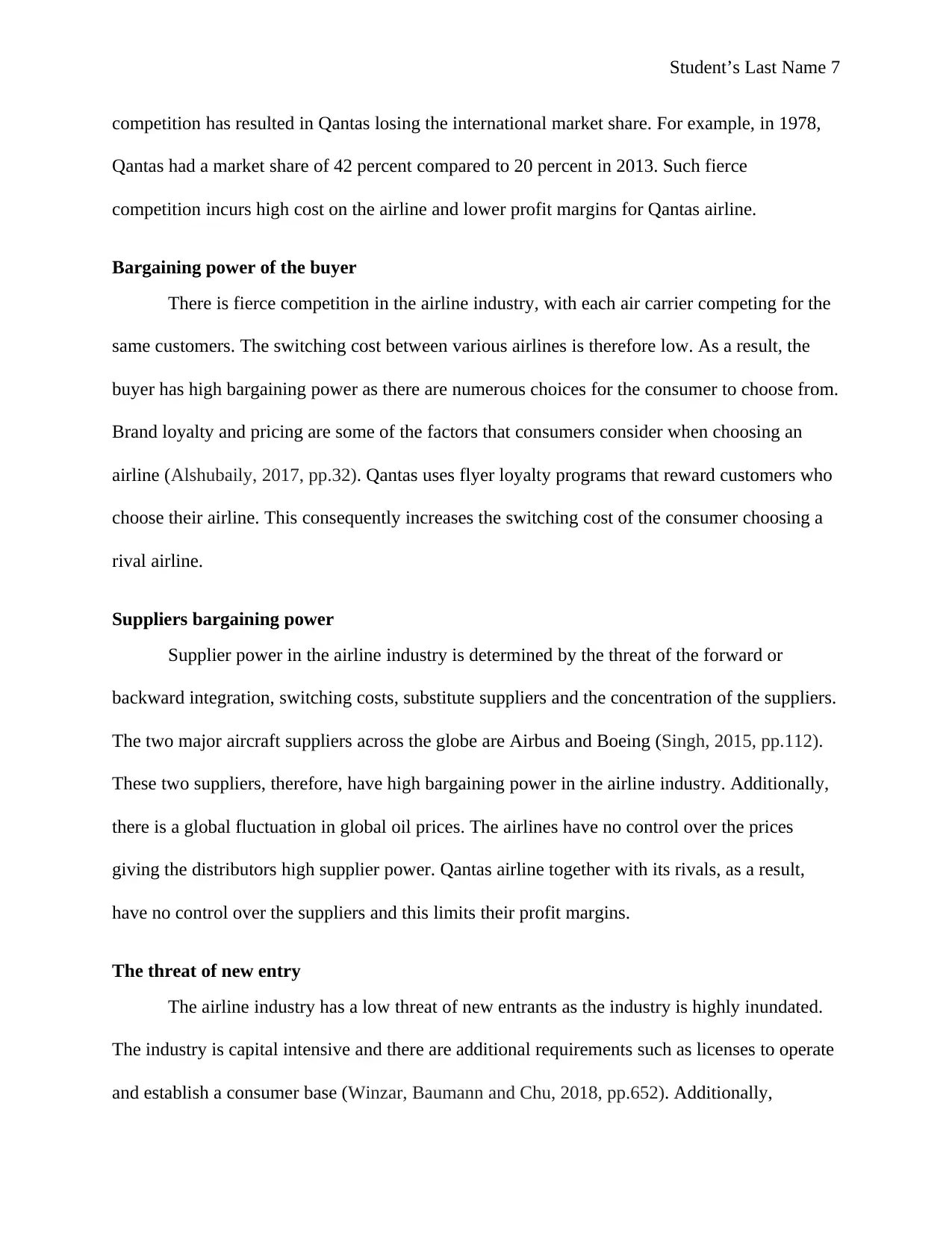
Student’s Last Name 7
competition has resulted in Qantas losing the international market share. For example, in 1978,
Qantas had a market share of 42 percent compared to 20 percent in 2013. Such fierce
competition incurs high cost on the airline and lower profit margins for Qantas airline.
Bargaining power of the buyer
There is fierce competition in the airline industry, with each air carrier competing for the
same customers. The switching cost between various airlines is therefore low. As a result, the
buyer has high bargaining power as there are numerous choices for the consumer to choose from.
Brand loyalty and pricing are some of the factors that consumers consider when choosing an
airline (Alshubaily, 2017, pp.32). Qantas uses flyer loyalty programs that reward customers who
choose their airline. This consequently increases the switching cost of the consumer choosing a
rival airline.
Suppliers bargaining power
Supplier power in the airline industry is determined by the threat of the forward or
backward integration, switching costs, substitute suppliers and the concentration of the suppliers.
The two major aircraft suppliers across the globe are Airbus and Boeing (Singh, 2015, pp.112).
These two suppliers, therefore, have high bargaining power in the airline industry. Additionally,
there is a global fluctuation in global oil prices. The airlines have no control over the prices
giving the distributors high supplier power. Qantas airline together with its rivals, as a result,
have no control over the suppliers and this limits their profit margins.
The threat of new entry
The airline industry has a low threat of new entrants as the industry is highly inundated.
The industry is capital intensive and there are additional requirements such as licenses to operate
and establish a consumer base (Winzar, Baumann and Chu, 2018, pp.652). Additionally,
competition has resulted in Qantas losing the international market share. For example, in 1978,
Qantas had a market share of 42 percent compared to 20 percent in 2013. Such fierce
competition incurs high cost on the airline and lower profit margins for Qantas airline.
Bargaining power of the buyer
There is fierce competition in the airline industry, with each air carrier competing for the
same customers. The switching cost between various airlines is therefore low. As a result, the
buyer has high bargaining power as there are numerous choices for the consumer to choose from.
Brand loyalty and pricing are some of the factors that consumers consider when choosing an
airline (Alshubaily, 2017, pp.32). Qantas uses flyer loyalty programs that reward customers who
choose their airline. This consequently increases the switching cost of the consumer choosing a
rival airline.
Suppliers bargaining power
Supplier power in the airline industry is determined by the threat of the forward or
backward integration, switching costs, substitute suppliers and the concentration of the suppliers.
The two major aircraft suppliers across the globe are Airbus and Boeing (Singh, 2015, pp.112).
These two suppliers, therefore, have high bargaining power in the airline industry. Additionally,
there is a global fluctuation in global oil prices. The airlines have no control over the prices
giving the distributors high supplier power. Qantas airline together with its rivals, as a result,
have no control over the suppliers and this limits their profit margins.
The threat of new entry
The airline industry has a low threat of new entrants as the industry is highly inundated.
The industry is capital intensive and there are additional requirements such as licenses to operate
and establish a consumer base (Winzar, Baumann and Chu, 2018, pp.652). Additionally,
Paraphrase This Document
Need a fresh take? Get an instant paraphrase of this document with our AI Paraphraser
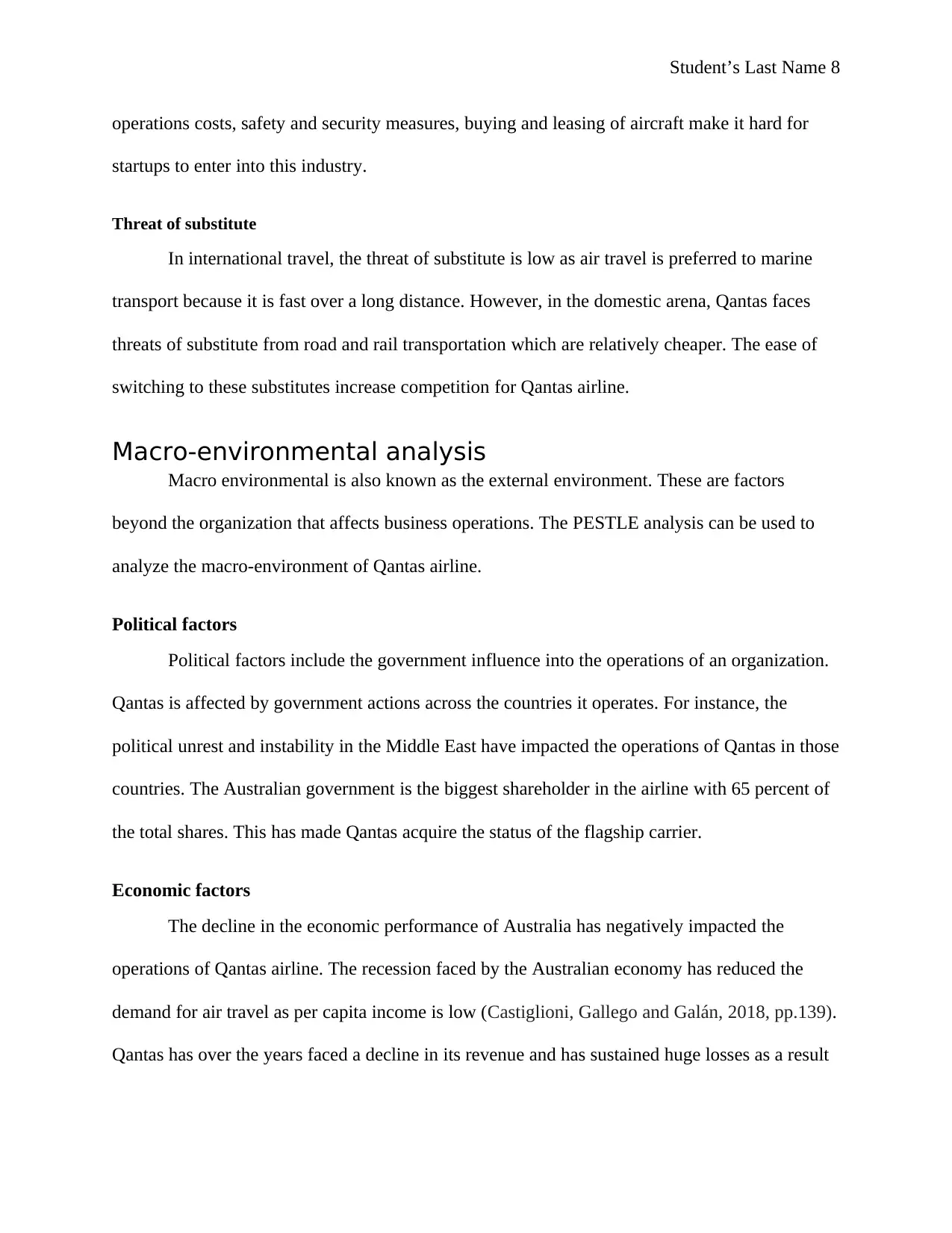
Student’s Last Name 8
operations costs, safety and security measures, buying and leasing of aircraft make it hard for
startups to enter into this industry.
Threat of substitute
In international travel, the threat of substitute is low as air travel is preferred to marine
transport because it is fast over a long distance. However, in the domestic arena, Qantas faces
threats of substitute from road and rail transportation which are relatively cheaper. The ease of
switching to these substitutes increase competition for Qantas airline.
Macro-environmental analysis
Macro environmental is also known as the external environment. These are factors
beyond the organization that affects business operations. The PESTLE analysis can be used to
analyze the macro-environment of Qantas airline.
Political factors
Political factors include the government influence into the operations of an organization.
Qantas is affected by government actions across the countries it operates. For instance, the
political unrest and instability in the Middle East have impacted the operations of Qantas in those
countries. The Australian government is the biggest shareholder in the airline with 65 percent of
the total shares. This has made Qantas acquire the status of the flagship carrier.
Economic factors
The decline in the economic performance of Australia has negatively impacted the
operations of Qantas airline. The recession faced by the Australian economy has reduced the
demand for air travel as per capita income is low (Castiglioni, Gallego and Galán, 2018, pp.139).
Qantas has over the years faced a decline in its revenue and has sustained huge losses as a result
operations costs, safety and security measures, buying and leasing of aircraft make it hard for
startups to enter into this industry.
Threat of substitute
In international travel, the threat of substitute is low as air travel is preferred to marine
transport because it is fast over a long distance. However, in the domestic arena, Qantas faces
threats of substitute from road and rail transportation which are relatively cheaper. The ease of
switching to these substitutes increase competition for Qantas airline.
Macro-environmental analysis
Macro environmental is also known as the external environment. These are factors
beyond the organization that affects business operations. The PESTLE analysis can be used to
analyze the macro-environment of Qantas airline.
Political factors
Political factors include the government influence into the operations of an organization.
Qantas is affected by government actions across the countries it operates. For instance, the
political unrest and instability in the Middle East have impacted the operations of Qantas in those
countries. The Australian government is the biggest shareholder in the airline with 65 percent of
the total shares. This has made Qantas acquire the status of the flagship carrier.
Economic factors
The decline in the economic performance of Australia has negatively impacted the
operations of Qantas airline. The recession faced by the Australian economy has reduced the
demand for air travel as per capita income is low (Castiglioni, Gallego and Galán, 2018, pp.139).
Qantas has over the years faced a decline in its revenue and has sustained huge losses as a result
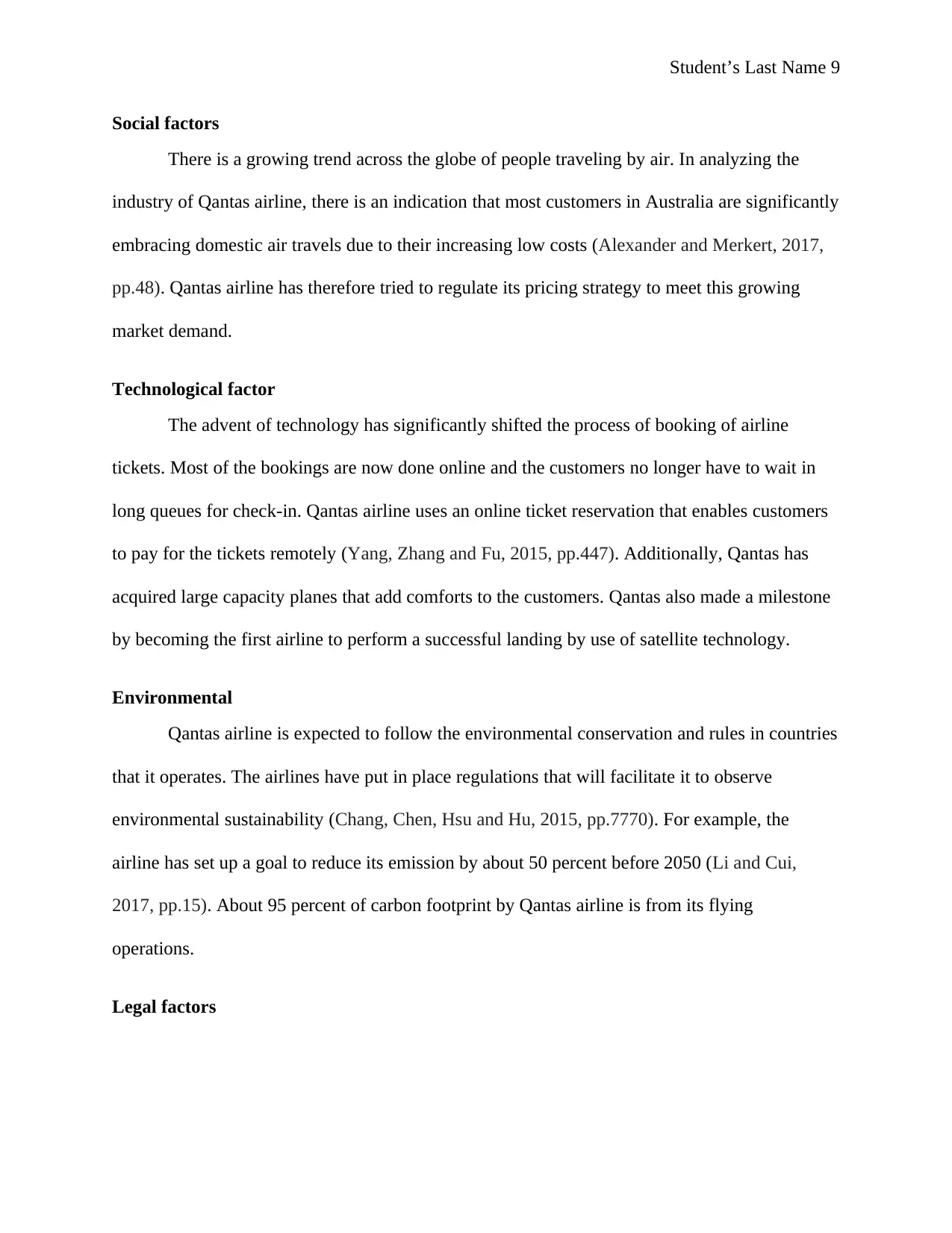
Student’s Last Name 9
Social factors
There is a growing trend across the globe of people traveling by air. In analyzing the
industry of Qantas airline, there is an indication that most customers in Australia are significantly
embracing domestic air travels due to their increasing low costs (Alexander and Merkert, 2017,
pp.48). Qantas airline has therefore tried to regulate its pricing strategy to meet this growing
market demand.
Technological factor
The advent of technology has significantly shifted the process of booking of airline
tickets. Most of the bookings are now done online and the customers no longer have to wait in
long queues for check-in. Qantas airline uses an online ticket reservation that enables customers
to pay for the tickets remotely (Yang, Zhang and Fu, 2015, pp.447). Additionally, Qantas has
acquired large capacity planes that add comforts to the customers. Qantas also made a milestone
by becoming the first airline to perform a successful landing by use of satellite technology.
Environmental
Qantas airline is expected to follow the environmental conservation and rules in countries
that it operates. The airlines have put in place regulations that will facilitate it to observe
environmental sustainability (Chang, Chen, Hsu and Hu, 2015, pp.7770). For example, the
airline has set up a goal to reduce its emission by about 50 percent before 2050 (Li and Cui,
2017, pp.15). About 95 percent of carbon footprint by Qantas airline is from its flying
operations.
Legal factors
Social factors
There is a growing trend across the globe of people traveling by air. In analyzing the
industry of Qantas airline, there is an indication that most customers in Australia are significantly
embracing domestic air travels due to their increasing low costs (Alexander and Merkert, 2017,
pp.48). Qantas airline has therefore tried to regulate its pricing strategy to meet this growing
market demand.
Technological factor
The advent of technology has significantly shifted the process of booking of airline
tickets. Most of the bookings are now done online and the customers no longer have to wait in
long queues for check-in. Qantas airline uses an online ticket reservation that enables customers
to pay for the tickets remotely (Yang, Zhang and Fu, 2015, pp.447). Additionally, Qantas has
acquired large capacity planes that add comforts to the customers. Qantas also made a milestone
by becoming the first airline to perform a successful landing by use of satellite technology.
Environmental
Qantas airline is expected to follow the environmental conservation and rules in countries
that it operates. The airlines have put in place regulations that will facilitate it to observe
environmental sustainability (Chang, Chen, Hsu and Hu, 2015, pp.7770). For example, the
airline has set up a goal to reduce its emission by about 50 percent before 2050 (Li and Cui,
2017, pp.15). About 95 percent of carbon footprint by Qantas airline is from its flying
operations.
Legal factors
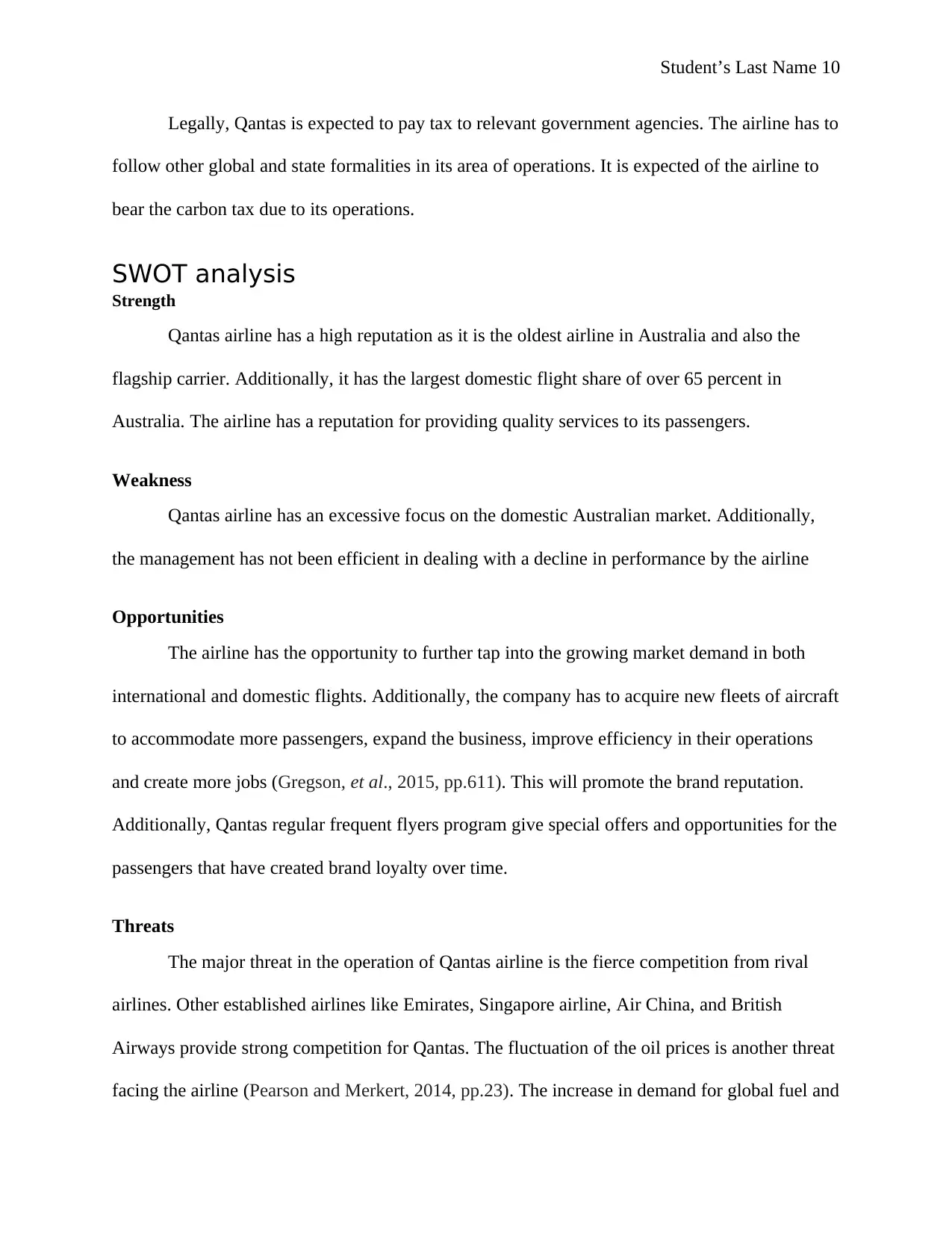
Student’s Last Name 10
Legally, Qantas is expected to pay tax to relevant government agencies. The airline has to
follow other global and state formalities in its area of operations. It is expected of the airline to
bear the carbon tax due to its operations.
SWOT analysis
Strength
Qantas airline has a high reputation as it is the oldest airline in Australia and also the
flagship carrier. Additionally, it has the largest domestic flight share of over 65 percent in
Australia. The airline has a reputation for providing quality services to its passengers.
Weakness
Qantas airline has an excessive focus on the domestic Australian market. Additionally,
the management has not been efficient in dealing with a decline in performance by the airline
Opportunities
The airline has the opportunity to further tap into the growing market demand in both
international and domestic flights. Additionally, the company has to acquire new fleets of aircraft
to accommodate more passengers, expand the business, improve efficiency in their operations
and create more jobs (Gregson, et al., 2015, pp.611). This will promote the brand reputation.
Additionally, Qantas regular frequent flyers program give special offers and opportunities for the
passengers that have created brand loyalty over time.
Threats
The major threat in the operation of Qantas airline is the fierce competition from rival
airlines. Other established airlines like Emirates, Singapore airline, Air China, and British
Airways provide strong competition for Qantas. The fluctuation of the oil prices is another threat
facing the airline (Pearson and Merkert, 2014, pp.23). The increase in demand for global fuel and
Legally, Qantas is expected to pay tax to relevant government agencies. The airline has to
follow other global and state formalities in its area of operations. It is expected of the airline to
bear the carbon tax due to its operations.
SWOT analysis
Strength
Qantas airline has a high reputation as it is the oldest airline in Australia and also the
flagship carrier. Additionally, it has the largest domestic flight share of over 65 percent in
Australia. The airline has a reputation for providing quality services to its passengers.
Weakness
Qantas airline has an excessive focus on the domestic Australian market. Additionally,
the management has not been efficient in dealing with a decline in performance by the airline
Opportunities
The airline has the opportunity to further tap into the growing market demand in both
international and domestic flights. Additionally, the company has to acquire new fleets of aircraft
to accommodate more passengers, expand the business, improve efficiency in their operations
and create more jobs (Gregson, et al., 2015, pp.611). This will promote the brand reputation.
Additionally, Qantas regular frequent flyers program give special offers and opportunities for the
passengers that have created brand loyalty over time.
Threats
The major threat in the operation of Qantas airline is the fierce competition from rival
airlines. Other established airlines like Emirates, Singapore airline, Air China, and British
Airways provide strong competition for Qantas. The fluctuation of the oil prices is another threat
facing the airline (Pearson and Merkert, 2014, pp.23). The increase in demand for global fuel and
Secure Best Marks with AI Grader
Need help grading? Try our AI Grader for instant feedback on your assignments.
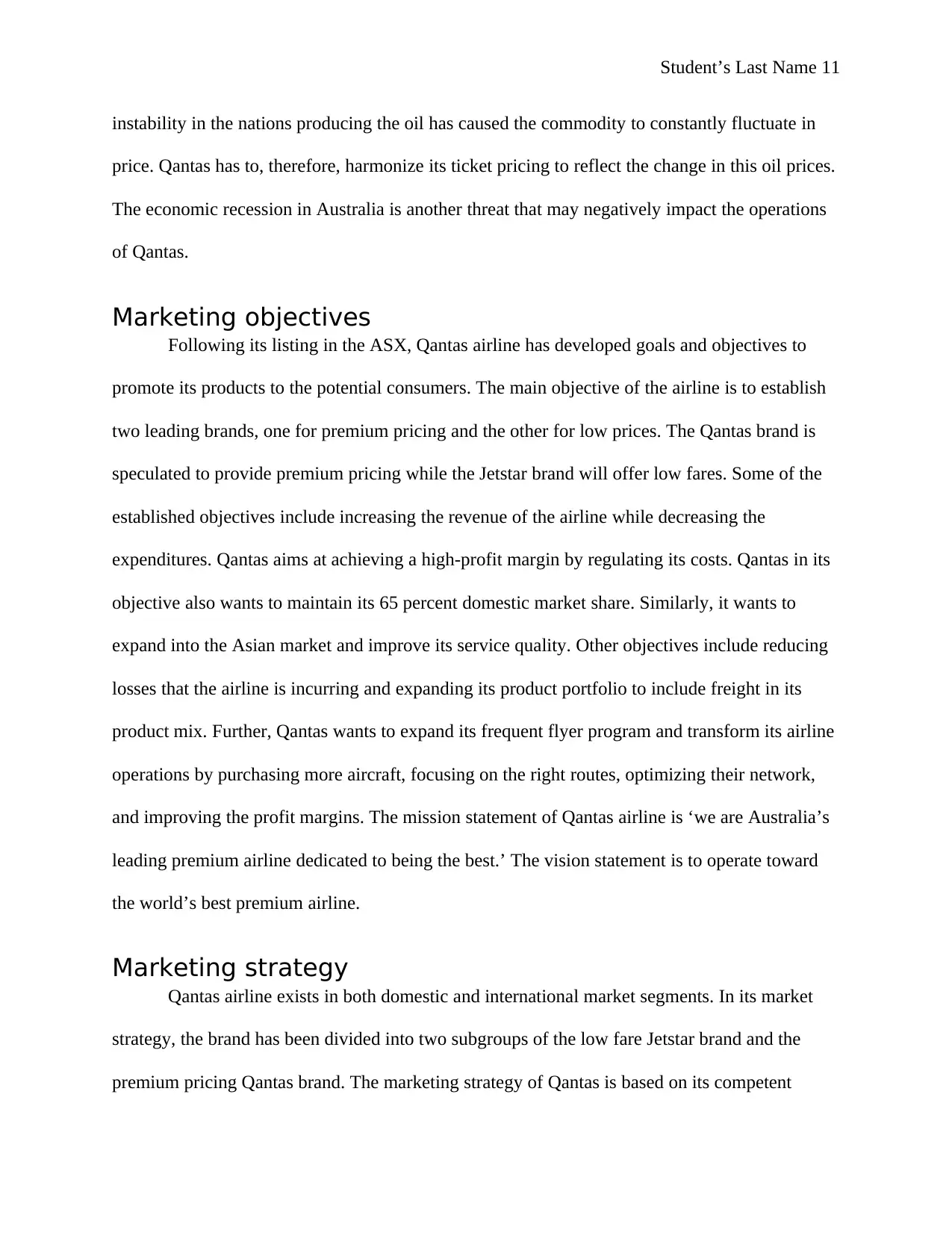
Student’s Last Name 11
instability in the nations producing the oil has caused the commodity to constantly fluctuate in
price. Qantas has to, therefore, harmonize its ticket pricing to reflect the change in this oil prices.
The economic recession in Australia is another threat that may negatively impact the operations
of Qantas.
Marketing objectives
Following its listing in the ASX, Qantas airline has developed goals and objectives to
promote its products to the potential consumers. The main objective of the airline is to establish
two leading brands, one for premium pricing and the other for low prices. The Qantas brand is
speculated to provide premium pricing while the Jetstar brand will offer low fares. Some of the
established objectives include increasing the revenue of the airline while decreasing the
expenditures. Qantas aims at achieving a high-profit margin by regulating its costs. Qantas in its
objective also wants to maintain its 65 percent domestic market share. Similarly, it wants to
expand into the Asian market and improve its service quality. Other objectives include reducing
losses that the airline is incurring and expanding its product portfolio to include freight in its
product mix. Further, Qantas wants to expand its frequent flyer program and transform its airline
operations by purchasing more aircraft, focusing on the right routes, optimizing their network,
and improving the profit margins. The mission statement of Qantas airline is ‘we are Australia’s
leading premium airline dedicated to being the best.’ The vision statement is to operate toward
the world’s best premium airline.
Marketing strategy
Qantas airline exists in both domestic and international market segments. In its market
strategy, the brand has been divided into two subgroups of the low fare Jetstar brand and the
premium pricing Qantas brand. The marketing strategy of Qantas is based on its competent
instability in the nations producing the oil has caused the commodity to constantly fluctuate in
price. Qantas has to, therefore, harmonize its ticket pricing to reflect the change in this oil prices.
The economic recession in Australia is another threat that may negatively impact the operations
of Qantas.
Marketing objectives
Following its listing in the ASX, Qantas airline has developed goals and objectives to
promote its products to the potential consumers. The main objective of the airline is to establish
two leading brands, one for premium pricing and the other for low prices. The Qantas brand is
speculated to provide premium pricing while the Jetstar brand will offer low fares. Some of the
established objectives include increasing the revenue of the airline while decreasing the
expenditures. Qantas aims at achieving a high-profit margin by regulating its costs. Qantas in its
objective also wants to maintain its 65 percent domestic market share. Similarly, it wants to
expand into the Asian market and improve its service quality. Other objectives include reducing
losses that the airline is incurring and expanding its product portfolio to include freight in its
product mix. Further, Qantas wants to expand its frequent flyer program and transform its airline
operations by purchasing more aircraft, focusing on the right routes, optimizing their network,
and improving the profit margins. The mission statement of Qantas airline is ‘we are Australia’s
leading premium airline dedicated to being the best.’ The vision statement is to operate toward
the world’s best premium airline.
Marketing strategy
Qantas airline exists in both domestic and international market segments. In its market
strategy, the brand has been divided into two subgroups of the low fare Jetstar brand and the
premium pricing Qantas brand. The marketing strategy of Qantas is based on its competent
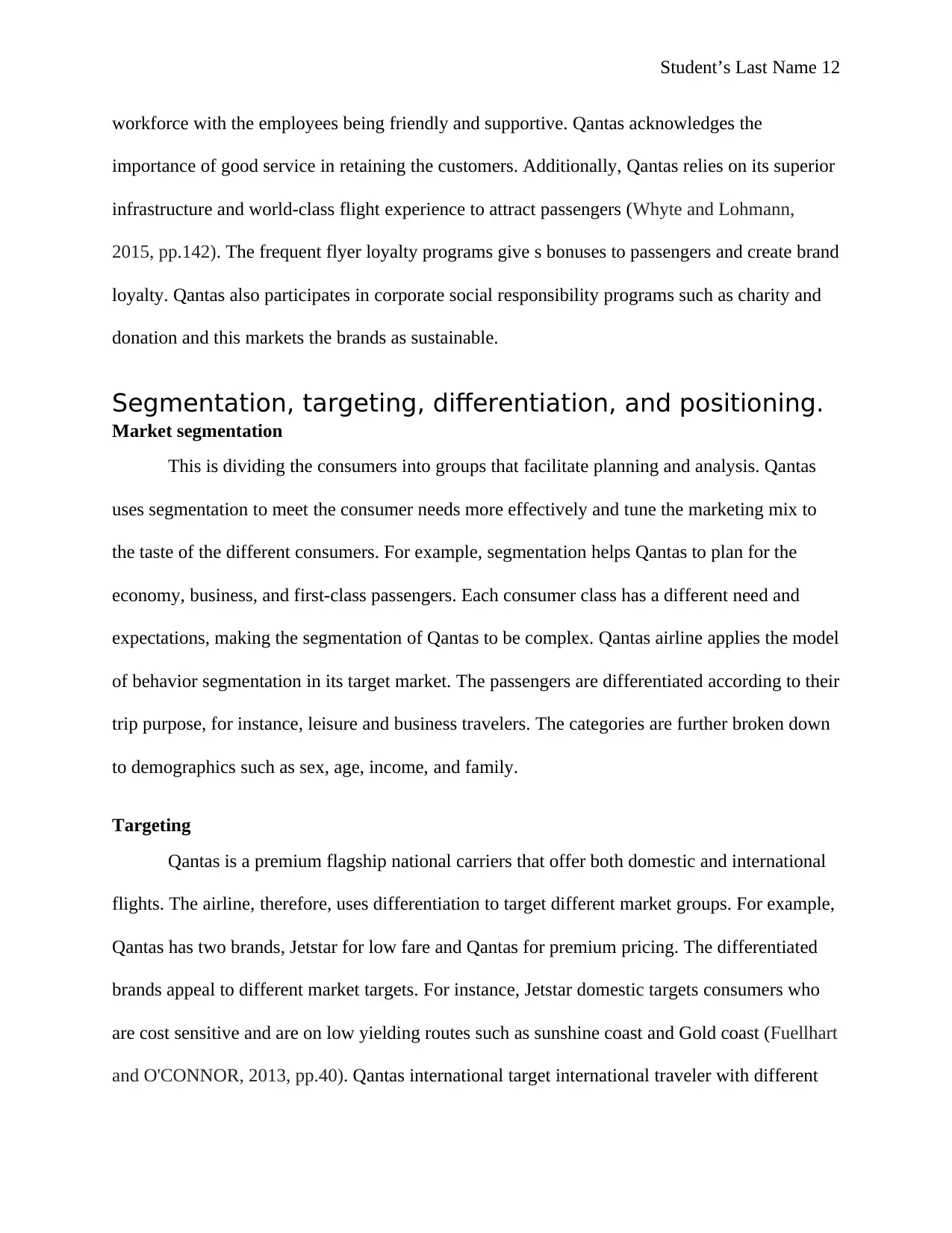
Student’s Last Name 12
workforce with the employees being friendly and supportive. Qantas acknowledges the
importance of good service in retaining the customers. Additionally, Qantas relies on its superior
infrastructure and world-class flight experience to attract passengers (Whyte and Lohmann,
2015, pp.142). The frequent flyer loyalty programs give s bonuses to passengers and create brand
loyalty. Qantas also participates in corporate social responsibility programs such as charity and
donation and this markets the brands as sustainable.
Segmentation, targeting, differentiation, and positioning.
Market segmentation
This is dividing the consumers into groups that facilitate planning and analysis. Qantas
uses segmentation to meet the consumer needs more effectively and tune the marketing mix to
the taste of the different consumers. For example, segmentation helps Qantas to plan for the
economy, business, and first-class passengers. Each consumer class has a different need and
expectations, making the segmentation of Qantas to be complex. Qantas airline applies the model
of behavior segmentation in its target market. The passengers are differentiated according to their
trip purpose, for instance, leisure and business travelers. The categories are further broken down
to demographics such as sex, age, income, and family.
Targeting
Qantas is a premium flagship national carriers that offer both domestic and international
flights. The airline, therefore, uses differentiation to target different market groups. For example,
Qantas has two brands, Jetstar for low fare and Qantas for premium pricing. The differentiated
brands appeal to different market targets. For instance, Jetstar domestic targets consumers who
are cost sensitive and are on low yielding routes such as sunshine coast and Gold coast (Fuellhart
and O'CONNOR, 2013, pp.40). Qantas international target international traveler with different
workforce with the employees being friendly and supportive. Qantas acknowledges the
importance of good service in retaining the customers. Additionally, Qantas relies on its superior
infrastructure and world-class flight experience to attract passengers (Whyte and Lohmann,
2015, pp.142). The frequent flyer loyalty programs give s bonuses to passengers and create brand
loyalty. Qantas also participates in corporate social responsibility programs such as charity and
donation and this markets the brands as sustainable.
Segmentation, targeting, differentiation, and positioning.
Market segmentation
This is dividing the consumers into groups that facilitate planning and analysis. Qantas
uses segmentation to meet the consumer needs more effectively and tune the marketing mix to
the taste of the different consumers. For example, segmentation helps Qantas to plan for the
economy, business, and first-class passengers. Each consumer class has a different need and
expectations, making the segmentation of Qantas to be complex. Qantas airline applies the model
of behavior segmentation in its target market. The passengers are differentiated according to their
trip purpose, for instance, leisure and business travelers. The categories are further broken down
to demographics such as sex, age, income, and family.
Targeting
Qantas is a premium flagship national carriers that offer both domestic and international
flights. The airline, therefore, uses differentiation to target different market groups. For example,
Qantas has two brands, Jetstar for low fare and Qantas for premium pricing. The differentiated
brands appeal to different market targets. For instance, Jetstar domestic targets consumers who
are cost sensitive and are on low yielding routes such as sunshine coast and Gold coast (Fuellhart
and O'CONNOR, 2013, pp.40). Qantas international target international traveler with different
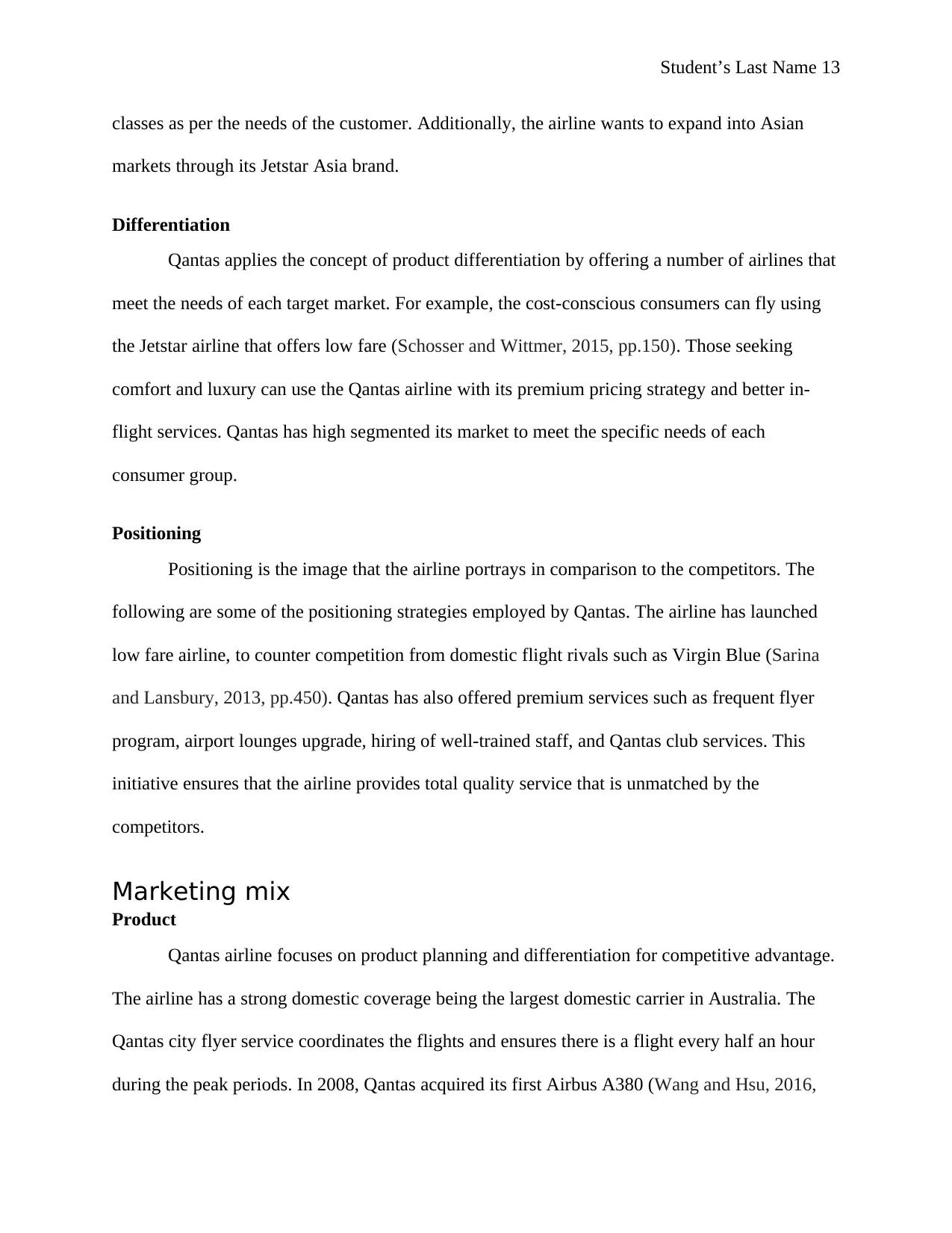
Student’s Last Name 13
classes as per the needs of the customer. Additionally, the airline wants to expand into Asian
markets through its Jetstar Asia brand.
Differentiation
Qantas applies the concept of product differentiation by offering a number of airlines that
meet the needs of each target market. For example, the cost-conscious consumers can fly using
the Jetstar airline that offers low fare (Schosser and Wittmer, 2015, pp.150). Those seeking
comfort and luxury can use the Qantas airline with its premium pricing strategy and better in-
flight services. Qantas has high segmented its market to meet the specific needs of each
consumer group.
Positioning
Positioning is the image that the airline portrays in comparison to the competitors. The
following are some of the positioning strategies employed by Qantas. The airline has launched
low fare airline, to counter competition from domestic flight rivals such as Virgin Blue (Sarina
and Lansbury, 2013, pp.450). Qantas has also offered premium services such as frequent flyer
program, airport lounges upgrade, hiring of well-trained staff, and Qantas club services. This
initiative ensures that the airline provides total quality service that is unmatched by the
competitors.
Marketing mix
Product
Qantas airline focuses on product planning and differentiation for competitive advantage.
The airline has a strong domestic coverage being the largest domestic carrier in Australia. The
Qantas city flyer service coordinates the flights and ensures there is a flight every half an hour
during the peak periods. In 2008, Qantas acquired its first Airbus A380 (Wang and Hsu, 2016,
classes as per the needs of the customer. Additionally, the airline wants to expand into Asian
markets through its Jetstar Asia brand.
Differentiation
Qantas applies the concept of product differentiation by offering a number of airlines that
meet the needs of each target market. For example, the cost-conscious consumers can fly using
the Jetstar airline that offers low fare (Schosser and Wittmer, 2015, pp.150). Those seeking
comfort and luxury can use the Qantas airline with its premium pricing strategy and better in-
flight services. Qantas has high segmented its market to meet the specific needs of each
consumer group.
Positioning
Positioning is the image that the airline portrays in comparison to the competitors. The
following are some of the positioning strategies employed by Qantas. The airline has launched
low fare airline, to counter competition from domestic flight rivals such as Virgin Blue (Sarina
and Lansbury, 2013, pp.450). Qantas has also offered premium services such as frequent flyer
program, airport lounges upgrade, hiring of well-trained staff, and Qantas club services. This
initiative ensures that the airline provides total quality service that is unmatched by the
competitors.
Marketing mix
Product
Qantas airline focuses on product planning and differentiation for competitive advantage.
The airline has a strong domestic coverage being the largest domestic carrier in Australia. The
Qantas city flyer service coordinates the flights and ensures there is a flight every half an hour
during the peak periods. In 2008, Qantas acquired its first Airbus A380 (Wang and Hsu, 2016,
Paraphrase This Document
Need a fresh take? Get an instant paraphrase of this document with our AI Paraphraser
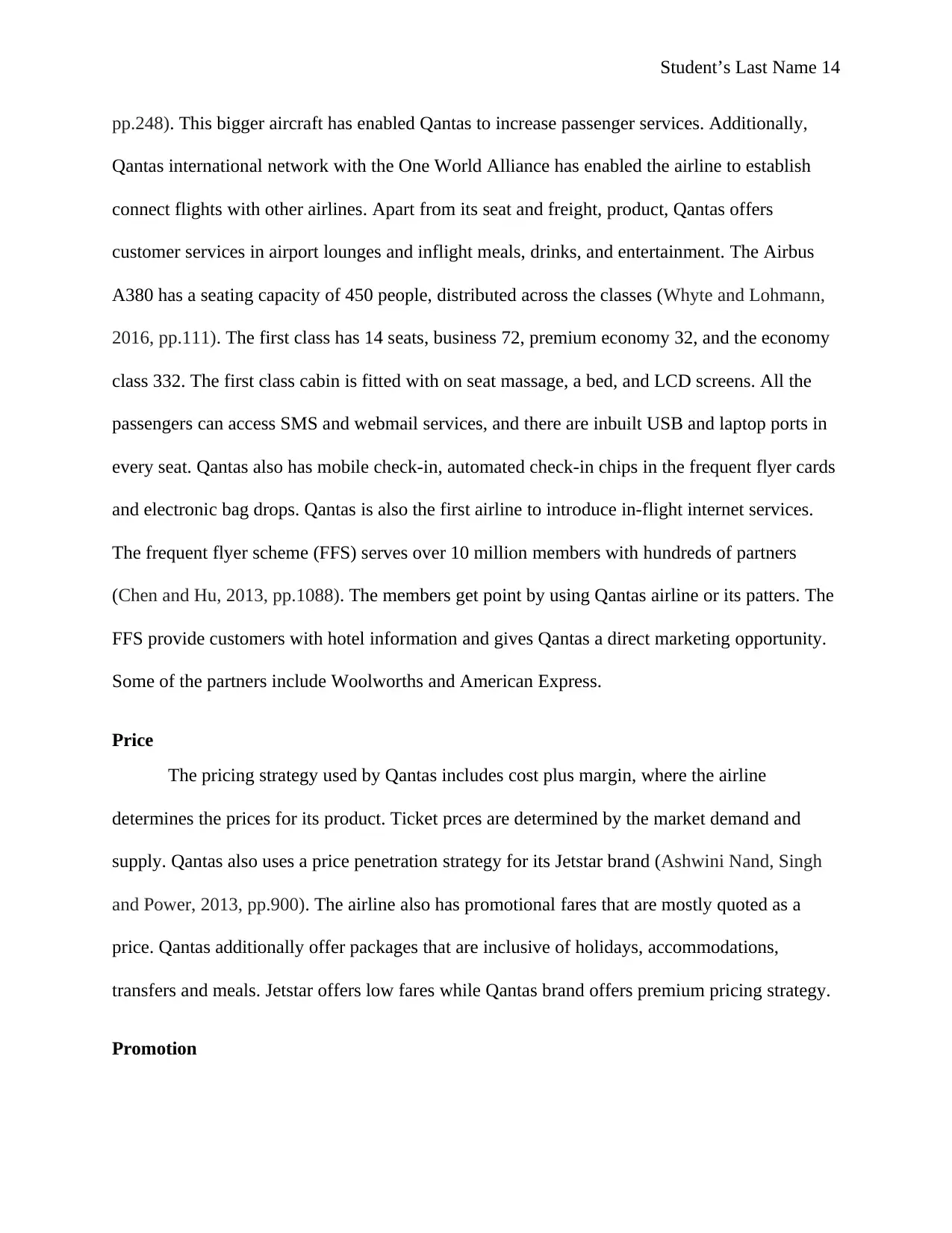
Student’s Last Name 14
pp.248). This bigger aircraft has enabled Qantas to increase passenger services. Additionally,
Qantas international network with the One World Alliance has enabled the airline to establish
connect flights with other airlines. Apart from its seat and freight, product, Qantas offers
customer services in airport lounges and inflight meals, drinks, and entertainment. The Airbus
A380 has a seating capacity of 450 people, distributed across the classes (Whyte and Lohmann,
2016, pp.111). The first class has 14 seats, business 72, premium economy 32, and the economy
class 332. The first class cabin is fitted with on seat massage, a bed, and LCD screens. All the
passengers can access SMS and webmail services, and there are inbuilt USB and laptop ports in
every seat. Qantas also has mobile check-in, automated check-in chips in the frequent flyer cards
and electronic bag drops. Qantas is also the first airline to introduce in-flight internet services.
The frequent flyer scheme (FFS) serves over 10 million members with hundreds of partners
(Chen and Hu, 2013, pp.1088). The members get point by using Qantas airline or its patters. The
FFS provide customers with hotel information and gives Qantas a direct marketing opportunity.
Some of the partners include Woolworths and American Express.
Price
The pricing strategy used by Qantas includes cost plus margin, where the airline
determines the prices for its product. Ticket prces are determined by the market demand and
supply. Qantas also uses a price penetration strategy for its Jetstar brand (Ashwini Nand, Singh
and Power, 2013, pp.900). The airline also has promotional fares that are mostly quoted as a
price. Qantas additionally offer packages that are inclusive of holidays, accommodations,
transfers and meals. Jetstar offers low fares while Qantas brand offers premium pricing strategy.
Promotion
pp.248). This bigger aircraft has enabled Qantas to increase passenger services. Additionally,
Qantas international network with the One World Alliance has enabled the airline to establish
connect flights with other airlines. Apart from its seat and freight, product, Qantas offers
customer services in airport lounges and inflight meals, drinks, and entertainment. The Airbus
A380 has a seating capacity of 450 people, distributed across the classes (Whyte and Lohmann,
2016, pp.111). The first class has 14 seats, business 72, premium economy 32, and the economy
class 332. The first class cabin is fitted with on seat massage, a bed, and LCD screens. All the
passengers can access SMS and webmail services, and there are inbuilt USB and laptop ports in
every seat. Qantas also has mobile check-in, automated check-in chips in the frequent flyer cards
and electronic bag drops. Qantas is also the first airline to introduce in-flight internet services.
The frequent flyer scheme (FFS) serves over 10 million members with hundreds of partners
(Chen and Hu, 2013, pp.1088). The members get point by using Qantas airline or its patters. The
FFS provide customers with hotel information and gives Qantas a direct marketing opportunity.
Some of the partners include Woolworths and American Express.
Price
The pricing strategy used by Qantas includes cost plus margin, where the airline
determines the prices for its product. Ticket prces are determined by the market demand and
supply. Qantas also uses a price penetration strategy for its Jetstar brand (Ashwini Nand, Singh
and Power, 2013, pp.900). The airline also has promotional fares that are mostly quoted as a
price. Qantas additionally offer packages that are inclusive of holidays, accommodations,
transfers and meals. Jetstar offers low fares while Qantas brand offers premium pricing strategy.
Promotion
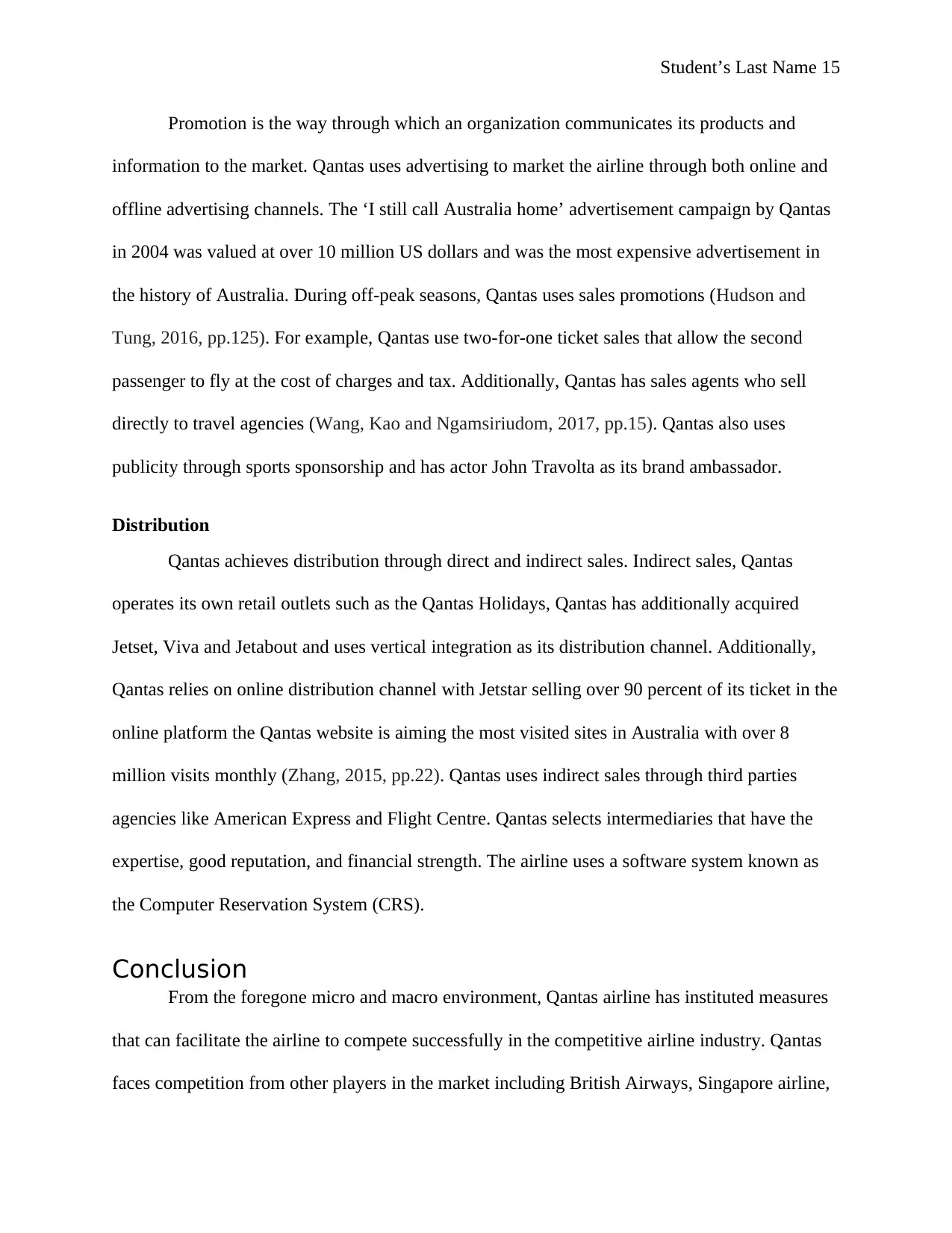
Student’s Last Name 15
Promotion is the way through which an organization communicates its products and
information to the market. Qantas uses advertising to market the airline through both online and
offline advertising channels. The ‘I still call Australia home’ advertisement campaign by Qantas
in 2004 was valued at over 10 million US dollars and was the most expensive advertisement in
the history of Australia. During off-peak seasons, Qantas uses sales promotions (Hudson and
Tung, 2016, pp.125). For example, Qantas use two-for-one ticket sales that allow the second
passenger to fly at the cost of charges and tax. Additionally, Qantas has sales agents who sell
directly to travel agencies (Wang, Kao and Ngamsiriudom, 2017, pp.15). Qantas also uses
publicity through sports sponsorship and has actor John Travolta as its brand ambassador.
Distribution
Qantas achieves distribution through direct and indirect sales. Indirect sales, Qantas
operates its own retail outlets such as the Qantas Holidays, Qantas has additionally acquired
Jetset, Viva and Jetabout and uses vertical integration as its distribution channel. Additionally,
Qantas relies on online distribution channel with Jetstar selling over 90 percent of its ticket in the
online platform the Qantas website is aiming the most visited sites in Australia with over 8
million visits monthly (Zhang, 2015, pp.22). Qantas uses indirect sales through third parties
agencies like American Express and Flight Centre. Qantas selects intermediaries that have the
expertise, good reputation, and financial strength. The airline uses a software system known as
the Computer Reservation System (CRS).
Conclusion
From the foregone micro and macro environment, Qantas airline has instituted measures
that can facilitate the airline to compete successfully in the competitive airline industry. Qantas
faces competition from other players in the market including British Airways, Singapore airline,
Promotion is the way through which an organization communicates its products and
information to the market. Qantas uses advertising to market the airline through both online and
offline advertising channels. The ‘I still call Australia home’ advertisement campaign by Qantas
in 2004 was valued at over 10 million US dollars and was the most expensive advertisement in
the history of Australia. During off-peak seasons, Qantas uses sales promotions (Hudson and
Tung, 2016, pp.125). For example, Qantas use two-for-one ticket sales that allow the second
passenger to fly at the cost of charges and tax. Additionally, Qantas has sales agents who sell
directly to travel agencies (Wang, Kao and Ngamsiriudom, 2017, pp.15). Qantas also uses
publicity through sports sponsorship and has actor John Travolta as its brand ambassador.
Distribution
Qantas achieves distribution through direct and indirect sales. Indirect sales, Qantas
operates its own retail outlets such as the Qantas Holidays, Qantas has additionally acquired
Jetset, Viva and Jetabout and uses vertical integration as its distribution channel. Additionally,
Qantas relies on online distribution channel with Jetstar selling over 90 percent of its ticket in the
online platform the Qantas website is aiming the most visited sites in Australia with over 8
million visits monthly (Zhang, 2015, pp.22). Qantas uses indirect sales through third parties
agencies like American Express and Flight Centre. Qantas selects intermediaries that have the
expertise, good reputation, and financial strength. The airline uses a software system known as
the Computer Reservation System (CRS).
Conclusion
From the foregone micro and macro environment, Qantas airline has instituted measures
that can facilitate the airline to compete successfully in the competitive airline industry. Qantas
faces competition from other players in the market including British Airways, Singapore airline,
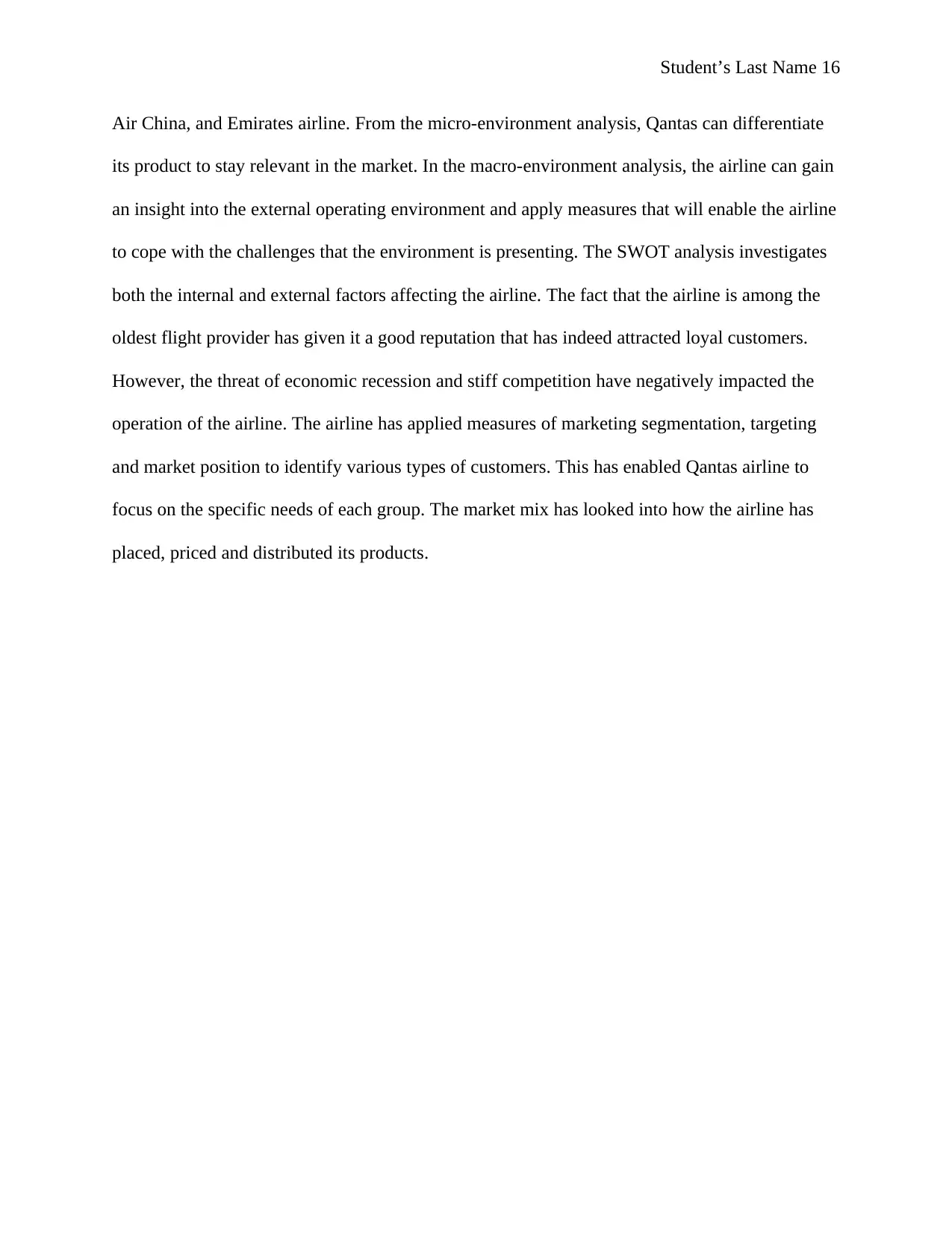
Student’s Last Name 16
Air China, and Emirates airline. From the micro-environment analysis, Qantas can differentiate
its product to stay relevant in the market. In the macro-environment analysis, the airline can gain
an insight into the external operating environment and apply measures that will enable the airline
to cope with the challenges that the environment is presenting. The SWOT analysis investigates
both the internal and external factors affecting the airline. The fact that the airline is among the
oldest flight provider has given it a good reputation that has indeed attracted loyal customers.
However, the threat of economic recession and stiff competition have negatively impacted the
operation of the airline. The airline has applied measures of marketing segmentation, targeting
and market position to identify various types of customers. This has enabled Qantas airline to
focus on the specific needs of each group. The market mix has looked into how the airline has
placed, priced and distributed its products.
Air China, and Emirates airline. From the micro-environment analysis, Qantas can differentiate
its product to stay relevant in the market. In the macro-environment analysis, the airline can gain
an insight into the external operating environment and apply measures that will enable the airline
to cope with the challenges that the environment is presenting. The SWOT analysis investigates
both the internal and external factors affecting the airline. The fact that the airline is among the
oldest flight provider has given it a good reputation that has indeed attracted loyal customers.
However, the threat of economic recession and stiff competition have negatively impacted the
operation of the airline. The airline has applied measures of marketing segmentation, targeting
and market position to identify various types of customers. This has enabled Qantas airline to
focus on the specific needs of each group. The market mix has looked into how the airline has
placed, priced and distributed its products.
Secure Best Marks with AI Grader
Need help grading? Try our AI Grader for instant feedback on your assignments.
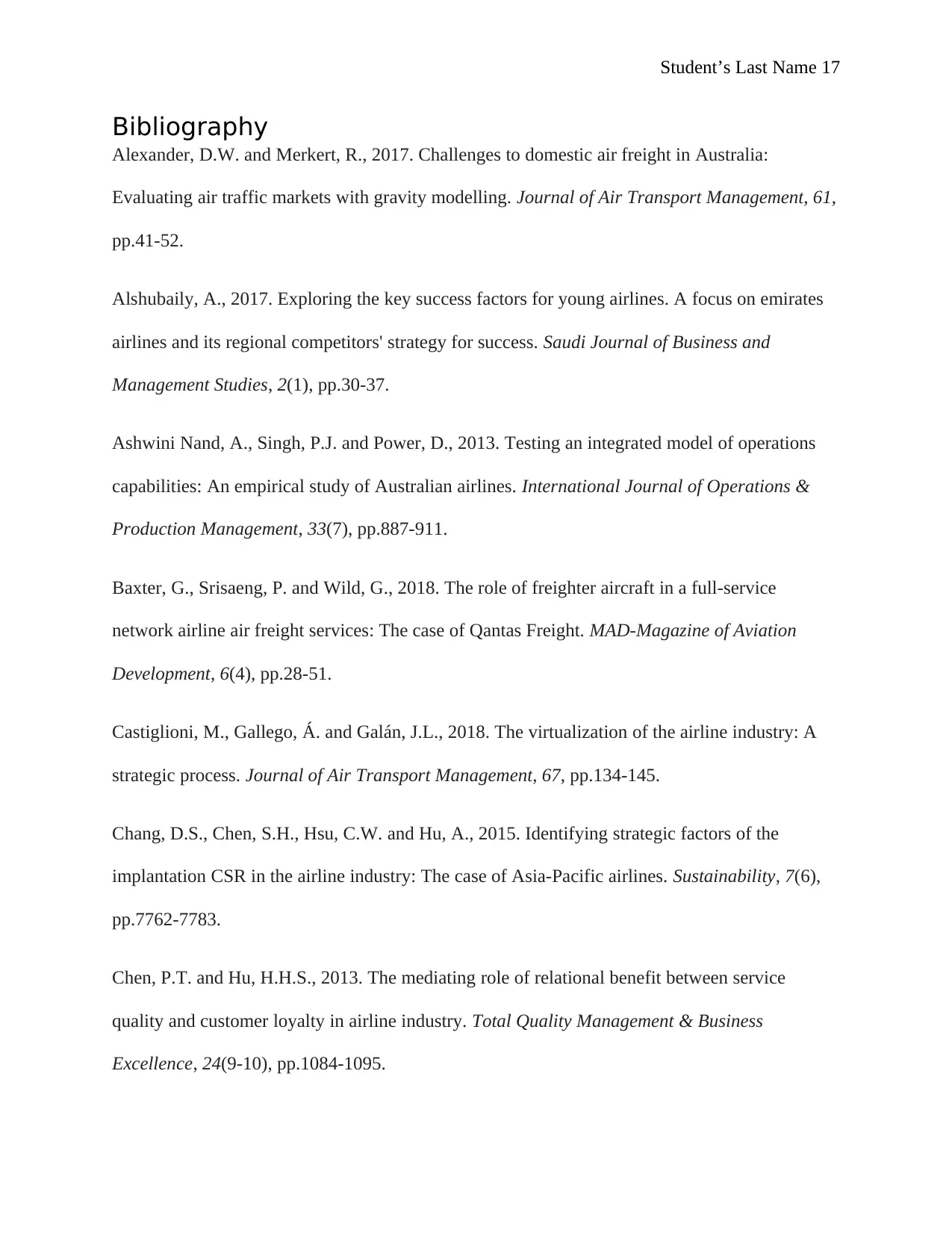
Student’s Last Name 17
Bibliography
Alexander, D.W. and Merkert, R., 2017. Challenges to domestic air freight in Australia:
Evaluating air traffic markets with gravity modelling. Journal of Air Transport Management, 61,
pp.41-52.
Alshubaily, A., 2017. Exploring the key success factors for young airlines. A focus on emirates
airlines and its regional competitors' strategy for success. Saudi Journal of Business and
Management Studies, 2(1), pp.30-37.
Ashwini Nand, A., Singh, P.J. and Power, D., 2013. Testing an integrated model of operations
capabilities: An empirical study of Australian airlines. International Journal of Operations &
Production Management, 33(7), pp.887-911.
Baxter, G., Srisaeng, P. and Wild, G., 2018. The role of freighter aircraft in a full-service
network airline air freight services: The case of Qantas Freight. MAD-Magazine of Aviation
Development, 6(4), pp.28-51.
Castiglioni, M., Gallego, Á. and Galán, J.L., 2018. The virtualization of the airline industry: A
strategic process. Journal of Air Transport Management, 67, pp.134-145.
Chang, D.S., Chen, S.H., Hsu, C.W. and Hu, A., 2015. Identifying strategic factors of the
implantation CSR in the airline industry: The case of Asia-Pacific airlines. Sustainability, 7(6),
pp.7762-7783.
Chen, P.T. and Hu, H.H.S., 2013. The mediating role of relational benefit between service
quality and customer loyalty in airline industry. Total Quality Management & Business
Excellence, 24(9-10), pp.1084-1095.
Bibliography
Alexander, D.W. and Merkert, R., 2017. Challenges to domestic air freight in Australia:
Evaluating air traffic markets with gravity modelling. Journal of Air Transport Management, 61,
pp.41-52.
Alshubaily, A., 2017. Exploring the key success factors for young airlines. A focus on emirates
airlines and its regional competitors' strategy for success. Saudi Journal of Business and
Management Studies, 2(1), pp.30-37.
Ashwini Nand, A., Singh, P.J. and Power, D., 2013. Testing an integrated model of operations
capabilities: An empirical study of Australian airlines. International Journal of Operations &
Production Management, 33(7), pp.887-911.
Baxter, G., Srisaeng, P. and Wild, G., 2018. The role of freighter aircraft in a full-service
network airline air freight services: The case of Qantas Freight. MAD-Magazine of Aviation
Development, 6(4), pp.28-51.
Castiglioni, M., Gallego, Á. and Galán, J.L., 2018. The virtualization of the airline industry: A
strategic process. Journal of Air Transport Management, 67, pp.134-145.
Chang, D.S., Chen, S.H., Hsu, C.W. and Hu, A., 2015. Identifying strategic factors of the
implantation CSR in the airline industry: The case of Asia-Pacific airlines. Sustainability, 7(6),
pp.7762-7783.
Chen, P.T. and Hu, H.H.S., 2013. The mediating role of relational benefit between service
quality and customer loyalty in airline industry. Total Quality Management & Business
Excellence, 24(9-10), pp.1084-1095.
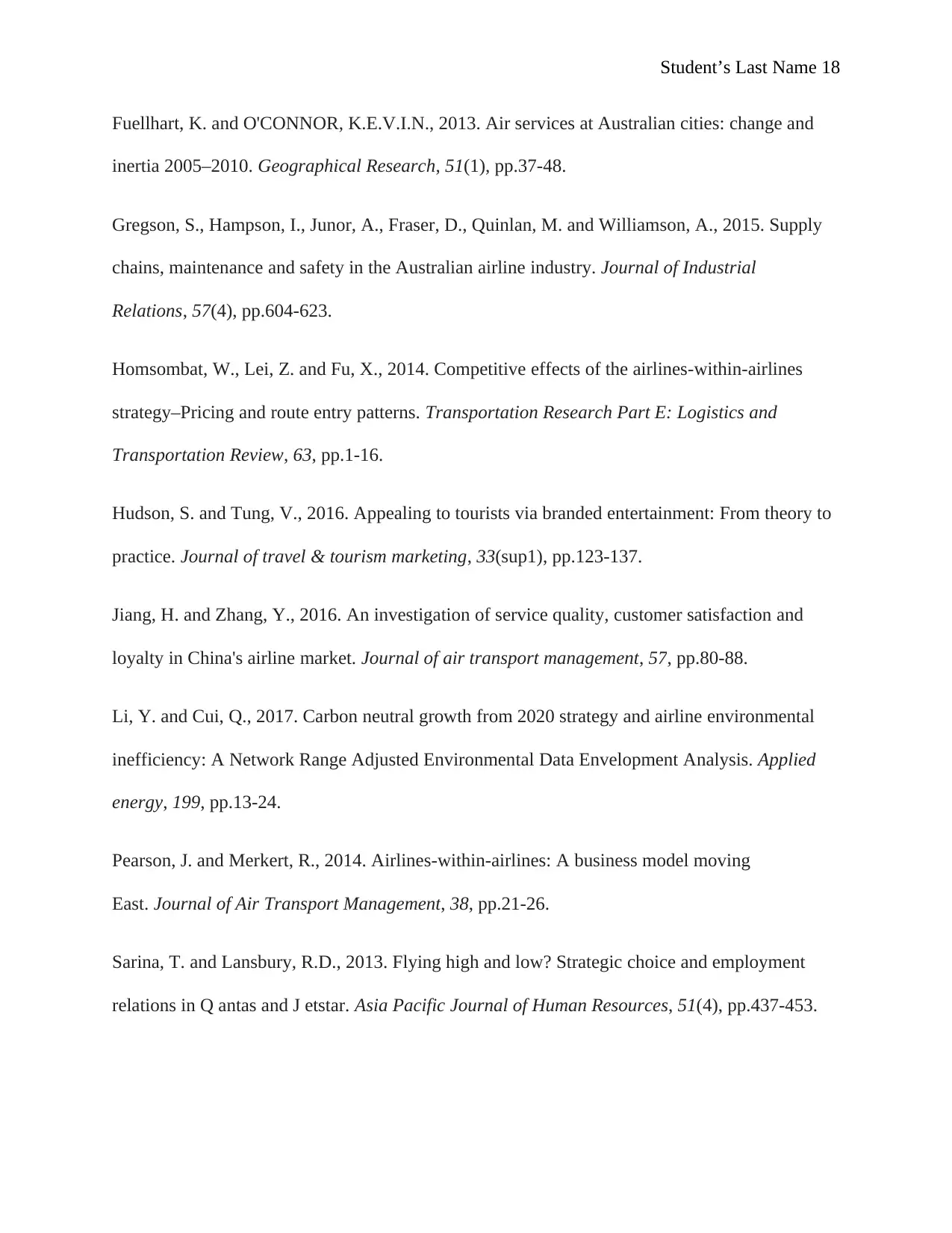
Student’s Last Name 18
Fuellhart, K. and O'CONNOR, K.E.V.I.N., 2013. Air services at Australian cities: change and
inertia 2005–2010. Geographical Research, 51(1), pp.37-48.
Gregson, S., Hampson, I., Junor, A., Fraser, D., Quinlan, M. and Williamson, A., 2015. Supply
chains, maintenance and safety in the Australian airline industry. Journal of Industrial
Relations, 57(4), pp.604-623.
Homsombat, W., Lei, Z. and Fu, X., 2014. Competitive effects of the airlines-within-airlines
strategy–Pricing and route entry patterns. Transportation Research Part E: Logistics and
Transportation Review, 63, pp.1-16.
Hudson, S. and Tung, V., 2016. Appealing to tourists via branded entertainment: From theory to
practice. Journal of travel & tourism marketing, 33(sup1), pp.123-137.
Jiang, H. and Zhang, Y., 2016. An investigation of service quality, customer satisfaction and
loyalty in China's airline market. Journal of air transport management, 57, pp.80-88.
Li, Y. and Cui, Q., 2017. Carbon neutral growth from 2020 strategy and airline environmental
inefficiency: A Network Range Adjusted Environmental Data Envelopment Analysis. Applied
energy, 199, pp.13-24.
Pearson, J. and Merkert, R., 2014. Airlines-within-airlines: A business model moving
East. Journal of Air Transport Management, 38, pp.21-26.
Sarina, T. and Lansbury, R.D., 2013. Flying high and low? Strategic choice and employment
relations in Q antas and J etstar. Asia Pacific Journal of Human Resources, 51(4), pp.437-453.
Fuellhart, K. and O'CONNOR, K.E.V.I.N., 2013. Air services at Australian cities: change and
inertia 2005–2010. Geographical Research, 51(1), pp.37-48.
Gregson, S., Hampson, I., Junor, A., Fraser, D., Quinlan, M. and Williamson, A., 2015. Supply
chains, maintenance and safety in the Australian airline industry. Journal of Industrial
Relations, 57(4), pp.604-623.
Homsombat, W., Lei, Z. and Fu, X., 2014. Competitive effects of the airlines-within-airlines
strategy–Pricing and route entry patterns. Transportation Research Part E: Logistics and
Transportation Review, 63, pp.1-16.
Hudson, S. and Tung, V., 2016. Appealing to tourists via branded entertainment: From theory to
practice. Journal of travel & tourism marketing, 33(sup1), pp.123-137.
Jiang, H. and Zhang, Y., 2016. An investigation of service quality, customer satisfaction and
loyalty in China's airline market. Journal of air transport management, 57, pp.80-88.
Li, Y. and Cui, Q., 2017. Carbon neutral growth from 2020 strategy and airline environmental
inefficiency: A Network Range Adjusted Environmental Data Envelopment Analysis. Applied
energy, 199, pp.13-24.
Pearson, J. and Merkert, R., 2014. Airlines-within-airlines: A business model moving
East. Journal of Air Transport Management, 38, pp.21-26.
Sarina, T. and Lansbury, R.D., 2013. Flying high and low? Strategic choice and employment
relations in Q antas and J etstar. Asia Pacific Journal of Human Resources, 51(4), pp.437-453.
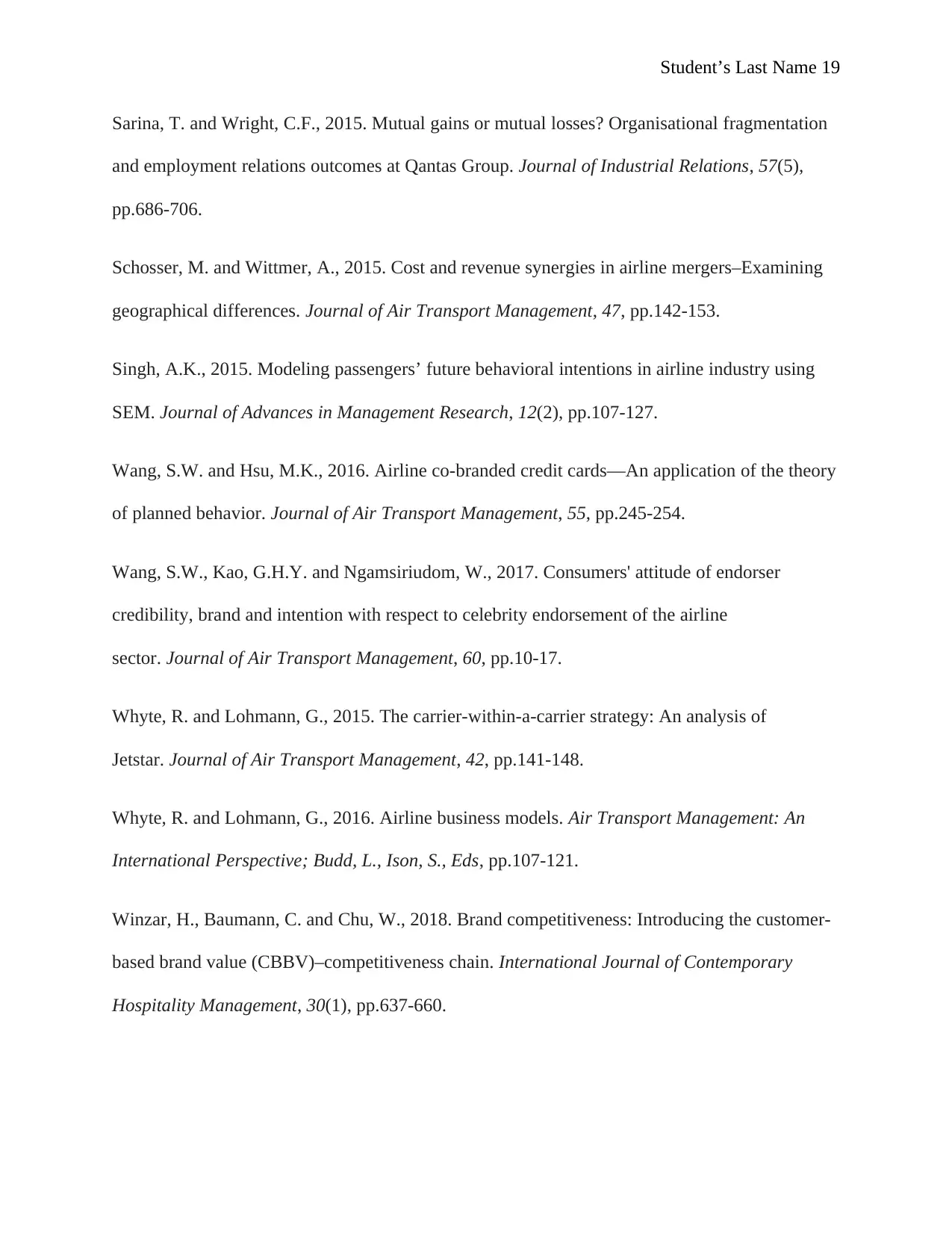
Student’s Last Name 19
Sarina, T. and Wright, C.F., 2015. Mutual gains or mutual losses? Organisational fragmentation
and employment relations outcomes at Qantas Group. Journal of Industrial Relations, 57(5),
pp.686-706.
Schosser, M. and Wittmer, A., 2015. Cost and revenue synergies in airline mergers–Examining
geographical differences. Journal of Air Transport Management, 47, pp.142-153.
Singh, A.K., 2015. Modeling passengers’ future behavioral intentions in airline industry using
SEM. Journal of Advances in Management Research, 12(2), pp.107-127.
Wang, S.W. and Hsu, M.K., 2016. Airline co-branded credit cards—An application of the theory
of planned behavior. Journal of Air Transport Management, 55, pp.245-254.
Wang, S.W., Kao, G.H.Y. and Ngamsiriudom, W., 2017. Consumers' attitude of endorser
credibility, brand and intention with respect to celebrity endorsement of the airline
sector. Journal of Air Transport Management, 60, pp.10-17.
Whyte, R. and Lohmann, G., 2015. The carrier-within-a-carrier strategy: An analysis of
Jetstar. Journal of Air Transport Management, 42, pp.141-148.
Whyte, R. and Lohmann, G., 2016. Airline business models. Air Transport Management: An
International Perspective; Budd, L., Ison, S., Eds, pp.107-121.
Winzar, H., Baumann, C. and Chu, W., 2018. Brand competitiveness: Introducing the customer-
based brand value (CBBV)–competitiveness chain. International Journal of Contemporary
Hospitality Management, 30(1), pp.637-660.
Sarina, T. and Wright, C.F., 2015. Mutual gains or mutual losses? Organisational fragmentation
and employment relations outcomes at Qantas Group. Journal of Industrial Relations, 57(5),
pp.686-706.
Schosser, M. and Wittmer, A., 2015. Cost and revenue synergies in airline mergers–Examining
geographical differences. Journal of Air Transport Management, 47, pp.142-153.
Singh, A.K., 2015. Modeling passengers’ future behavioral intentions in airline industry using
SEM. Journal of Advances in Management Research, 12(2), pp.107-127.
Wang, S.W. and Hsu, M.K., 2016. Airline co-branded credit cards—An application of the theory
of planned behavior. Journal of Air Transport Management, 55, pp.245-254.
Wang, S.W., Kao, G.H.Y. and Ngamsiriudom, W., 2017. Consumers' attitude of endorser
credibility, brand and intention with respect to celebrity endorsement of the airline
sector. Journal of Air Transport Management, 60, pp.10-17.
Whyte, R. and Lohmann, G., 2015. The carrier-within-a-carrier strategy: An analysis of
Jetstar. Journal of Air Transport Management, 42, pp.141-148.
Whyte, R. and Lohmann, G., 2016. Airline business models. Air Transport Management: An
International Perspective; Budd, L., Ison, S., Eds, pp.107-121.
Winzar, H., Baumann, C. and Chu, W., 2018. Brand competitiveness: Introducing the customer-
based brand value (CBBV)–competitiveness chain. International Journal of Contemporary
Hospitality Management, 30(1), pp.637-660.
Paraphrase This Document
Need a fresh take? Get an instant paraphrase of this document with our AI Paraphraser
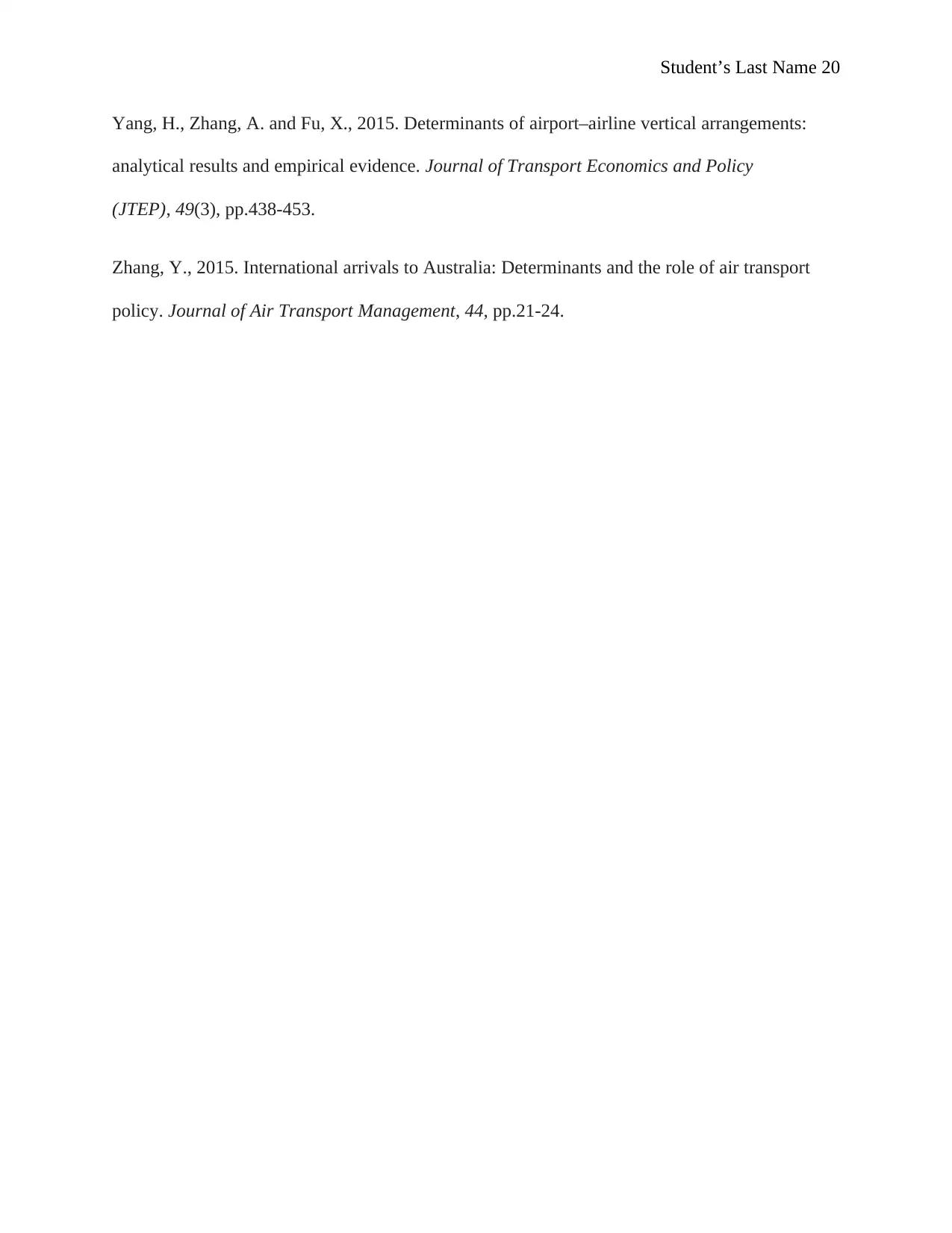
Student’s Last Name 20
Yang, H., Zhang, A. and Fu, X., 2015. Determinants of airport–airline vertical arrangements:
analytical results and empirical evidence. Journal of Transport Economics and Policy
(JTEP), 49(3), pp.438-453.
Zhang, Y., 2015. International arrivals to Australia: Determinants and the role of air transport
policy. Journal of Air Transport Management, 44, pp.21-24.
Yang, H., Zhang, A. and Fu, X., 2015. Determinants of airport–airline vertical arrangements:
analytical results and empirical evidence. Journal of Transport Economics and Policy
(JTEP), 49(3), pp.438-453.
Zhang, Y., 2015. International arrivals to Australia: Determinants and the role of air transport
policy. Journal of Air Transport Management, 44, pp.21-24.
1 out of 20
Related Documents
Your All-in-One AI-Powered Toolkit for Academic Success.
+13062052269
info@desklib.com
Available 24*7 on WhatsApp / Email
![[object Object]](/_next/static/media/star-bottom.7253800d.svg)
Unlock your academic potential
© 2024 | Zucol Services PVT LTD | All rights reserved.





